Delta Electronics orporated DFCM-NNN50 IEEE 802.11b/g/n Wireless LAN Plus Bluetooth Low Energy System On Chip Combo Module. User Manual
Delta Electronics Incorporated IEEE 802.11b/g/n Wireless LAN Plus Bluetooth Low Energy System On Chip Combo Module.
Users Manual
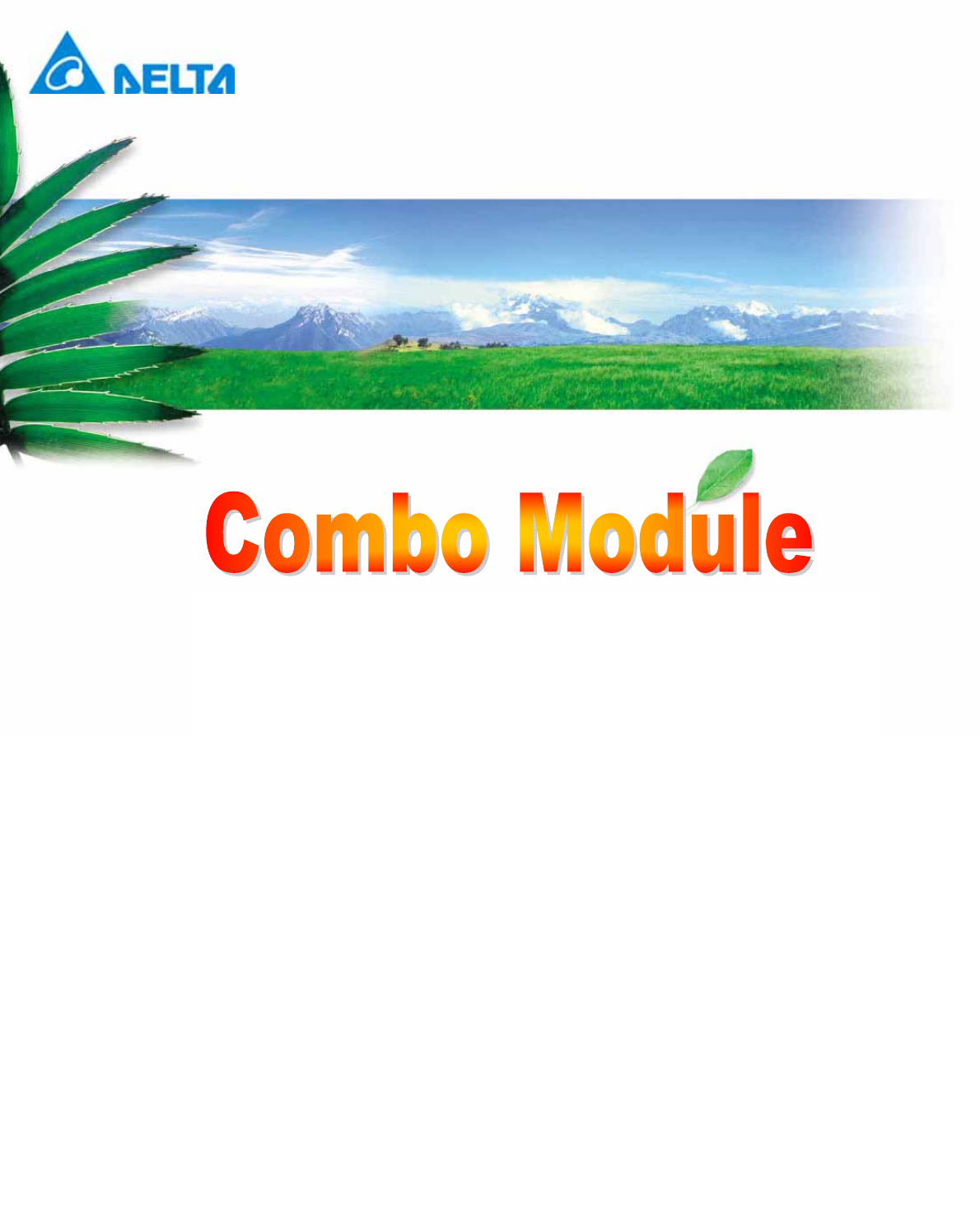
DFCM-NNN50-DT0R
Preliminary Data Sheet Sheet 1 of 41 Jun 27 2017
Proprietary Information and Specifications are Subject to Change
Data sheet
DFCM-NNN50-DT0R
A IEEE 802.11b/g/n Wireless LAN Plus Bluetooth
Low Energy System On Chip Combo Module.

DFCM-NNN50-DT0R
Preliminary Data Sheet Sheet 2 of 41 Jun 27 2017
Proprietary Information and Specifications are Subject to Change
Contents
1.Features ........................................................................................................................................... 5
1-1. General ......................................................................................................................................... 5
1-2. WLAN ......................................................................................................................................... 5
1-3. Bluetooth ..................................................................................................................................... 6
2.Model No. Definition ...................................................................................................................... 7
3.Block Diagram ................................................................................................................................ 8
4.General Specification ...................................................................................................................... 9
5.Electrical Characteristics ............................................................................................................... 10
5-1. Absolute Maximum Rating ........................................................................................................ 10
5-2. Recommended Operating Conditions ........................................................................................ 10
5-2.1. Operating Conditions .............................................................................................................. 10
5-2.2. Power Consumption................................................................................................................ 10
6.RF Characteristics ......................................................................................................................... 11
6-1. WLAN RF Characteristics ......................................................................................................... 11
6-2. Bluetooth Low Energy RF characteristics ................................................................................. 13
7.Pin Description .............................................................................................................................. 14
8.Slow Clock Requirement .............................................................................................................. 16
8-1. External 32.768KHz crystal oscillator ....................................................................................... 16
8-2. 32.768KHz RC oscillator .......................................................................................................... 16
8-3. 32.768KHz synthesized oscillator ............................................................................................. 17
9.Power-Up Sequence ...................................................................................................................... 18
10.Peripheral ...................................................................................................................................... 19
10-1. Timer/Counters (TIMER) ........................................................................................................ 20
10-2. Real Time Counter (RTC) ........................................................................................................ 20
10-3. AES Electronic Codebook Mode Encryption (ECB)............................................................... 21
10-4. AES CCM Mode Encryption (CCM) ...................................................................................... 21
10-5. Accelerated Address Resolver (AAR) ..................................................................................... 22
10-6. Random Number Generator (RNG)......................................................................................... 22
10-7. Watchdog Timer (WDT) .......................................................................................................... 23
10-8. Temperature sensor (TEMP) .................................................................................................... 23

DFCM-NNN50-DT0R
Preliminary Data Sheet Sheet 3 of 41 Jun 27 2017
Proprietary Information and Specifications are Subject to Change
10-9. BLE Serial Peripheral Interface (SPIS/SPI) ............................................................................ 24
10-9.1.SPI Slave Specifications and Parameters ...................................................................... 25
10-9.2.SPI Master Specifications and Parameters .................................................................... 26
10-10. Two-wire interface (TWI) ...................................................................................................... 27
10-11. Universal Asynchronous Receiver/Transmitter (UART) ....................................................... 29
10-12. Quadrature Decoder (QDEC) ................................................................................................ 29
10-13. Analog to Digital Converter (ADC) ...................................................................................... 30
10-14. GPIO Task Event block (GPIOTE) ....................................................................................... 31
10-15. Low Power Comparator (LPCOMP) ..................................................................................... 31
10-16. GPIO ...................................................................................................................................... 32
10-17. Debugger support................................................................................................................... 33
10-18. WLAN SPI Slave Interface ................................................................................................... 33
11.Reference Circuit .......................................................................................................................... 36
11-1. Standard Mode ................................................................................................................ 36
11-2. High Speed Mode ........................................................................................................... 37
12.Module Dimensions (mm) ............................................................................................................ 38
13.Recommend Soldering Conditions ............................................................................................... 39
14.Important Notice ........................................................................................................................... 40
14.1 Federal Communications Commission (FCC) Notice .............................................................. 40
14.2 National Communications Commission (NCC) Notice ............................................................ 41

DFCM-NNN50-DT0R
Preliminary Data Sheet Sheet 4 of 41 Jun 27 2017
Proprietary Information and Specifications are Subject to Change
Revision History
Version Date Reason of change Maker
S0.1 2016/8/15 Initial release Josh
S0.2 2016/11/23
Modify
1. RF TX output power and RX sensitivity spec
2. VBAT input voltage range
3. Delta logo, mechanical information and reflow
profile
4. Add reference schematic
Josh
S0.3 2016/12/07 Modify 5.2 Recommended Operating Conditions Josh
S0.4 2016/12/29 Add current consumption data
Modify 11-1、11-2 reference circuit
Josh
Junru
S0.5 2017/02/22 Modify application circuit and condition of voltage
Correct model no. definition Junru
S0.6 2017/05/22 Modify 6-1. WLAN RF Characteristics according to
3V3T test results Josh
S0.7 2017/06/22
Modify
1. Remove SDIO application circuit
2. Add important notice
Josh

DFCM-NNN50-DT0R
Preliminary Data Sheet Sheet 5 of 41 Jun 27 2017
Proprietary Information and Specifications are Subject to Change
DFCM-NNN5-DT0R
Wireless LAN/BLE SoC Combo Module
his document describes the DFCM-NNN50-DT0R wireless LAN/BLE SoC combo module hardware
specification. The modules provide cost effective, low power, and flexible platform to add Wi-Fi®
connectivity and BLE for embedded devices for a variety of applications, such as wireless sensors and
thermostats. It uses the wireless LAN chip and BLE SoC, which integrating the 2.4GHz transceiver, a 32 bit
ARM® Cortex M0 CPU, flash memory, and analog and digital peripherals.
1. Features
1-1. General
Integrated wireless LAN chip and BLE chip
Built in RF switch for BLE and WLAN using a single antenna
Integrated a 32 bit ARM® Cortex M0 CPU,256KB flash memory and 32KB RAM
Extra 256KB flash memory for user data storage.
8/9/10 bit ADC - 5 configurable channels
14 General Purpose I/O Pins
Two-wire Master (I2C compatible) support 100K bps and 400K bps
UART baud rate up to 921600 bps
SPI bit rate up to 4M bps
Quadrature Decoder (QDEC)
Temperature sensor
LGA42 pin package
Dimension 12.4mm(L) x 10.9mm(W) x 1.8mm(H)
RoHS compliant
1-2. WLAN
IEEE 802.11 b/g/n (1x1) for up to 65 Mbps
Superior Sensitivity and Range via advanced PHY signal processing
Advanced Equalization and Channel Estimation
Advanced Carrier and Timing Synchronization
Soft-AP support
T

DFCM-NNN50-DT0R
Preliminary Data Sheet Sheet 6 of 41 Jun 27 2017
Proprietary Information and Specifications are Subject to Change
Supports IEEE 802.11 WEP, WPA, WPA2 Security
SSL Security
On-Chip network stack offload MCU
- Integrated Network IP stack to minimize high speed mode host CPU requirements (4KB flash -
less than 1KB RAM, for Wi-Fi drivers)
- Network features TCP, UDP, DHCP, ARP, HTTP, SSL, and DNS
Support SPI host interface
1-3. Bluetooth
Bluetooth 4.1 specification compliant
AES HW encryption
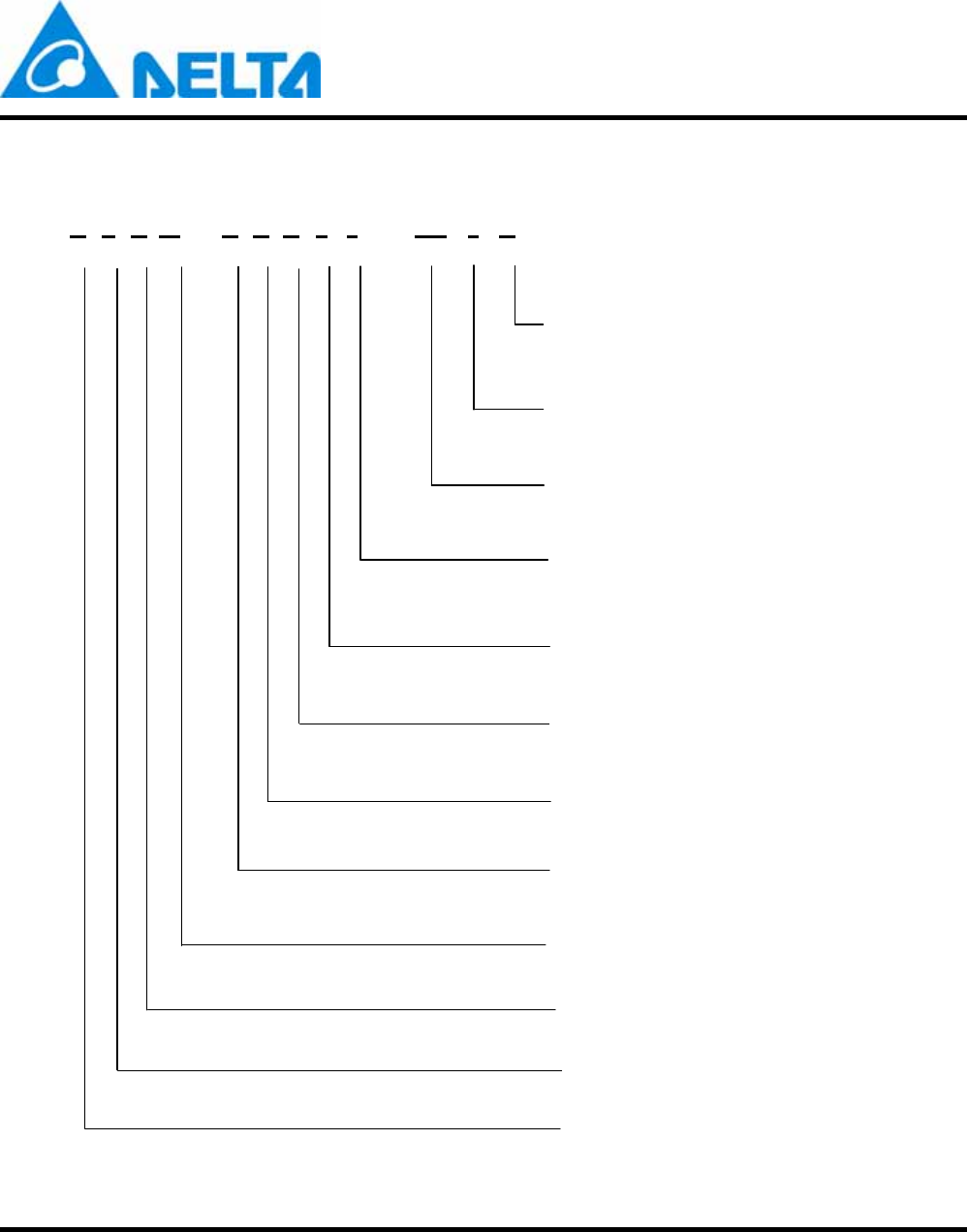
DFCM-NNN50-DT0R
Preliminary Data Sheet Sheet 7 of 41 Jun 27 2017
Proprietary Information and Specifications are Subject to Change
2. Model No. Definition
D F C M - N N N 5 0 -DT0 R
E=Pb free
R=RoHS
N=NG
L=Process with Lead
Customer code
Version
Lead Free
5= 12.4x10.9 mm
Dimension
WLAN Specification
M= Module
C= Combo
F= FR4
D= DELTA
N= IEEE 802.11b/g/n
WLAN Chip
Product-type
Property
Substrate
Company
N=Delta Define
0= WLAN + Bluetooth
DT= Delta Define
Bluetooth Chip N=Delta Define
0= Consumer Application
Serial no.
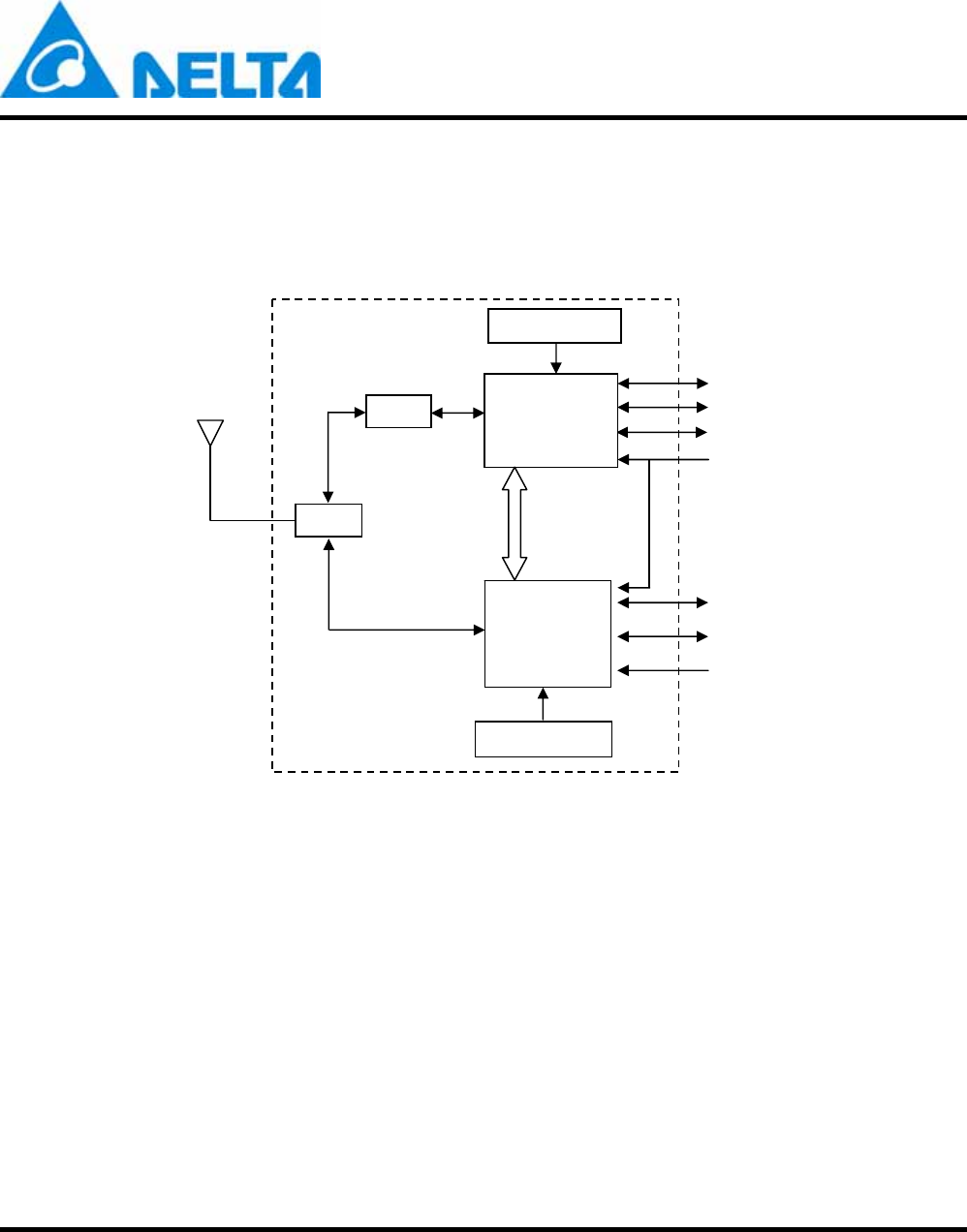
DFCM-NNN50-DT0R
Preliminary Data Sheet Sheet 8 of 41 Jun 27 2017
Proprietary Information and Specifications are Subject to Change
3. Block Diagram
Figure 3-1 DFCM-NNN50-DT0R Block Diagram
ADC
WLAN/Bluetooth ANT
WLAN Chip
26MHz Crystal
Balun
RF SW
UART/SPI/I2C
GPIO
GPIO
VDDIO
VBAT
BT SOC
32MHz Crystal
SPI

DFCM-NNN50-DT0R
Preliminary Data Sheet Sheet 9 of 41 Jun 27 2017
Proprietary Information and Specifications are Subject to Change
4. General Specification
Standard WLAN: IEEE 802.11 b/g/n
Bluetooth: V4.1
Frequency 2.412 ~ 2.484 GHz for WLAN
2.402 ~ 2.48 GHz for BT
Modulation 64QAM, 16QAM, QPSK, BPSK, CCK, DQPSK, DBPSK for WLAN
GFSK for Bluetooth
Data Rate
802.11b: 1, 2, 5.5, 11 Mbps
802.11g: 6, 9, 12, 18, 24, 36, 48, 54 Mbps
802.11n: 6.5, 13, 19.5, 26, 39, 52, 58.5, 65 Mbps
BLE: 0.25, 1, 2 Mbps
Operating Temperature -25~+85 ℃
Storage Temperature -40~+85 ℃
Antenna Impedance 50 ohm
Package Size 12.4 X 10.9 X 1.8 mm
Host Interface UART, SPI
Table 4-1 General Specification
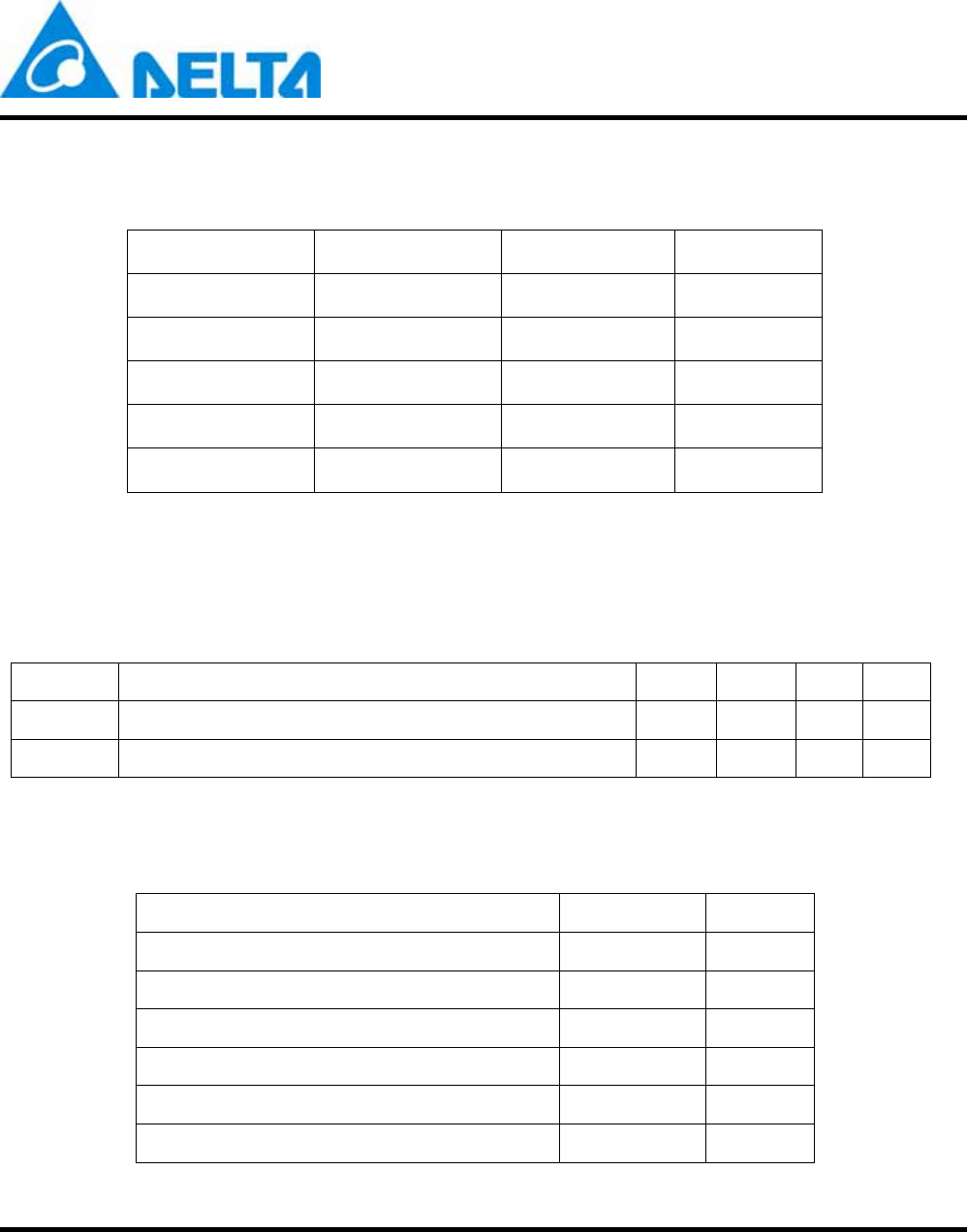
DFCM-NNN50-DT0R
Preliminary Data Sheet Sheet 10 of 41 Jun 27 2017
Proprietary Information and Specifications are Subject to Change
5. Electrical Characteristics
5-1. Absolute Maximum Rating
Symbol Min. Max. Units
VBAT -0.3 5.0 V
VDDIO -0.3 3.9 V
VGPIO -0.3 2.1 V
ESD-HBM 1 KV
ESD-CDM 500 V
Table 5-1 Absolute Maximum Rating
5-2. Recommended Operating Conditions
5-2.1. Operating Conditions
Symbol Parameter Min. Typ. Max. Unit
VBAT Supply voltage 3.0 3.3 4.2 V
VDDIO Supply voltage 2.7 3.3 3.6 V
Table 5-2 Operating Conditions
5-2.2. Power Consumption
Condition: VBAT=3.3V, VDDIO=3.3V, T=25℃
Conditions VBAT VDDIO.
Idle mode 3.7 uA 4.24 mA
Standby mode 3.7 uA 67 uA.
BLE RF TX mode 3.7 uA 18.6 mA
BLE RF RX mode 3.7uA 18 mA
WLAN RF TX mode 252 mA 29.1 mA
WLAN RF RX mode 75 mA 28.9 mA
Table 5-3 Power Consumption

DFCM-NNN50-DT0R
Preliminary Data Sheet Sheet 11 of 41 Jun 27 2017
Proprietary Information and Specifications are Subject to Change
6. RF Characteristics
6-1. WLAN RF Characteristics
Condition: VBAT=3.3V, VDDIO=3.3V, T=25℃
Item Condition Min. Typ. Max. Unit
802.11b Transmit
Transmit power level 11Mbps 8 12* 16 dBm
Transmit center frequency tolerance -25 0 +25 ppm
Transmit spectral mask
Fc-22MHz<F<Fc-11MHz &
Fc+11MHz<F<Fc+22MHz -30 dBr
F<Fc-22MHz&F>Fc+22MHz -50 dBr
Transmit modulation accuracy 11 35 %
802.11b Receiver
Receiver minimum input level
sensitivity (PER<8%) 11Mbps -84 -76 dBm
Receiver maximum input level
(PER<8%) -10 dBm
Table 6-1 WLAN 802.11b RF Characteristics
Condition: VBAT=3.3V, VDDIO=3.3V, T=25℃
Item Condition Min. Typ. Max. Unit
802.11g Transmit
Transmit power level 54Mbps 7.5 11.5* 15.5 dBm
Transmit center frequency tolerance -25 0 +25 ppm
RF carrier suppression Channel estimation phase -26 -15 dB
Transmit modulation accuracy 54Mbps -31 -25 dB
Transmit spectral mask
Fc-20MHz<F<Fc-11MHz
&Fc+11MHz<F<Fc+22MHz -20 dBr
F<Fc-30MHz&F>Fc-20MHz -28 dBr
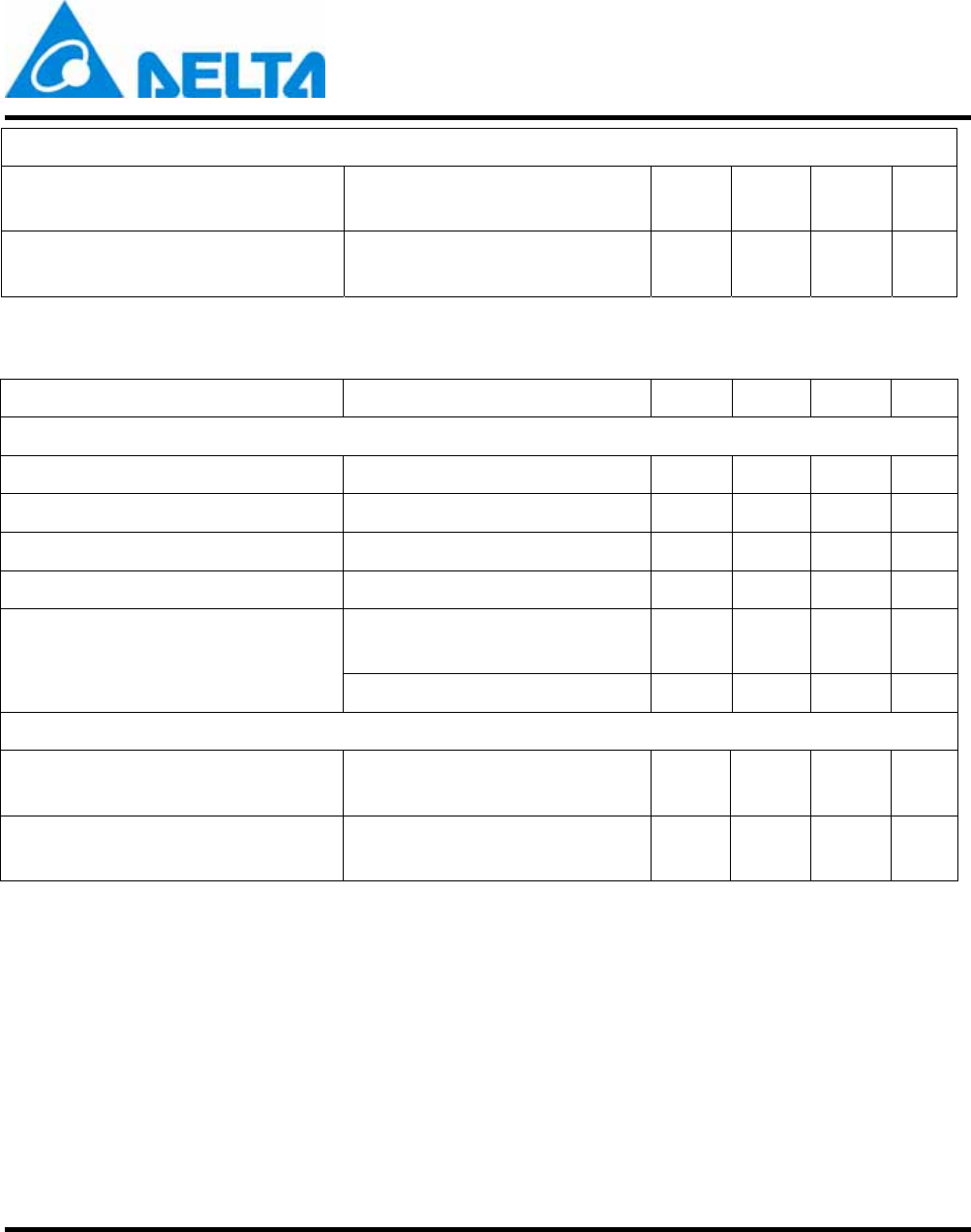
DFCM-NNN50-DT0R
Preliminary Data Sheet Sheet 12 of 41 Jun 27 2017
Proprietary Information and Specifications are Subject to Change
802.11g Receiver
Receiver minimum input level
sensitivity (PER<10%) 54Mbps -70 -65 dBm
Receiver maximum input level
(PER<10%) -20 dBm
Table 6-2 WLAN 802.11g RF Characteristics
Condition: VBAT=3.3V, VDDIO=3.3 V, T=25℃
Item Condition Min. Typ. Max. Unit
802.11n Transmit
Transmit power level 65Mbps 5 9* 13 dBm
Transmit center frequency tolerance -25 +25 ppm
RF carrier suppression Channel estimation phase -22 -15 dB
Transmit modulation accuracy 65Mbps -31 -27 dB
Transmit spectral mask
Fc-20MHz<F<Fc-11MHz
&Fc+11MHz<F<Fc+22MHz -20 dBr
F<Fc-30MHz&F>Fc-20MHz -28 dBr
802.11n Receiver
Receiver minimum input level
sensitivity (PER<10%) 65Mbps -65 -64 dBm
Receiver maximum input level
(PER<10%) -20 dBm
Table 6-3 WLAN 802.11n RF Characteristics
* Transmit power level may be degraded at extreme temperatures.
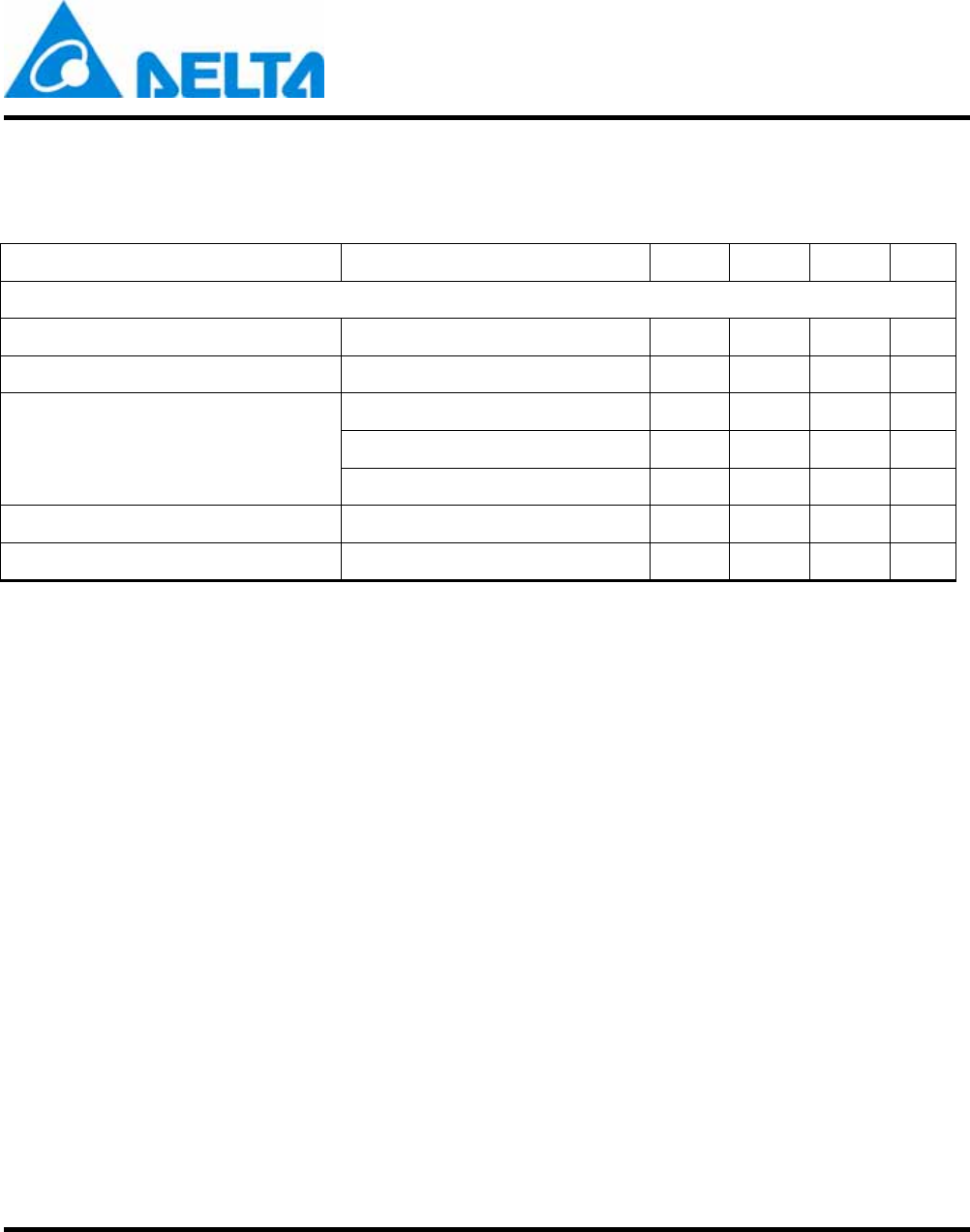
DFCM-NNN50-DT0R
Preliminary Data Sheet Sheet 13 of 41 Jun 27 2017
Proprietary Information and Specifications are Subject to Change
6-2. Bluetooth Low Energy RF characteristics
Condition: VDDIO=3.3V, T=25℃
Item Condition Min. Typ. Max. Unit
RF Characteristics
Output Power -20 2.5 8 dBm
Initial Frequency Offset -75 0 75 KHz
Modulation Characteristics
F1 Average 225 250 275 KHz
F2 Maximum 185 217 KHz
F2 / F1 Ratio 0.8 0.91
Sensitivity (PER<30.8%) 250Kbps -91 -70 dBm
Maximum Input Level (PER<30.8%) 250Kbps 0 dBm
Table 6-4 Bluetooth RF Characteristics

DFCM-NNN50-DT0R
Preliminary Data Sheet Sheet 14 of 41 Jun 27 2017
Proprietary Information and Specifications are Subject to Change
7. Pin Description
Pin Definition Function Description
1 BT_P0.23 Digital I/O Bluetooth General purpose I/O pin
2 BT_P0.03 Digital I/O Bluetooth General purpose I/O pin
3 GND Gnd Ground
4 ANT RF WLAN/Bluetooth RF input/output
5 GND Gnd Ground
6 BT_P0.25 Digital I/O Bluetooth general purpose I/O pin
7 BT_P0.13 Digital I/O Bluetooth general purpose I/O pin
8 BT_P0.20 Digital I/O Bluetooth general purpose I/O pin
9 BT_P0.17 Digital I/O Bluetooth general purpose I/O pin
10 BT_P0.16 Digital I/O Bluetooth general purpose I/O pin
11 BT_SWDCLK Digital input Hardware debug and flash programming I/O
12 BT_SWDIO Digital I/O
System reset (active low). Also hardware debug and flash
programming I/O
13 GND Gnd Ground
14 IRQN Digital I/O Interrupt pin to host
15 SPI_MOSI Digital I/O SPI_MOSI
16 WL_GPIO5 Digital I/O WLAN GPIO5, firmware debug purpose
17 GND Gnd Ground
18 WL_I2C_SDA Digital I/O WLAN I2C slave data, hardware debug purpose
19 WL_I2C_SCL Digital I/O WLAN I2C slave clock, hardware debug purpose
20 SD_DAT3 Digital I/O NC
21 SD_CLK Digital I/O NC
22 BT_P0.06 Digital I/O
Analog input
Bluetooth general purpose I/O pin
ADC input 7
ADC Reference voltage input 1
23 BT_P0.05 Digital I/O
Analog input
Bluetooth general purpose I/O pin
ADC input 6
24 BT_P0.04 Digital I/O Bluetooth general purpose I/O pin

DFCM-NNN50-DT0R
Preliminary Data Sheet Sheet 15 of 41 Jun 27 2017
Proprietary Information and Specifications are Subject to Change
24 BT_P0.04 Analog input ADC input 5
25 BT_P0.31 Digital I/O Bluetooth general purpose I/O pin
26 GND Gnd Ground
27 VBAT Power VBAT power supply input
28 GND Gnd Ground
29 BT_P0.30 Digital I/O Bluetooth general purpose I/O pin
30 BT_P0.00 Digital I/O
Analog input
General purpose I/O.
ADC Reference voltage.
31 SPI_MISO Digital I/O SPI_MISO
32 SPI_SCK Digital I/O SPI_SCK
33 SPI_SSN Digital I/O SPI_SSN
34 BT_P0.27 Digital I/O
Analog input
Bluetooth general purpose I/O pin
ADC input 1
Crystal connection for 32.768 kHz crystal oscillator or
external 32.768 kHz crystal reference
35 BT_P0.29 Digital I/O Bluetooth general purpose I/O pin
36 BT_P0.26 Digital I/O
Analog input
Bluetooth general purpose I/O pin
ADC input 0
Crystal connection for 32.768 kHz crystal oscillator
37 BT_P0.24 Digital I/O Bluetooth general purpose I/O pin
38 GND Gnd Ground
39 VDDIO Power Power supply input of VDDIO
40 GND Gnd Ground
41 BT_P0.21 Digital I/O Bluetooth general purpose I/O pin
42 BT_P0.22 Digital I/O Bluetooth general purpose I/O pin
Table 7-1 Pin Description
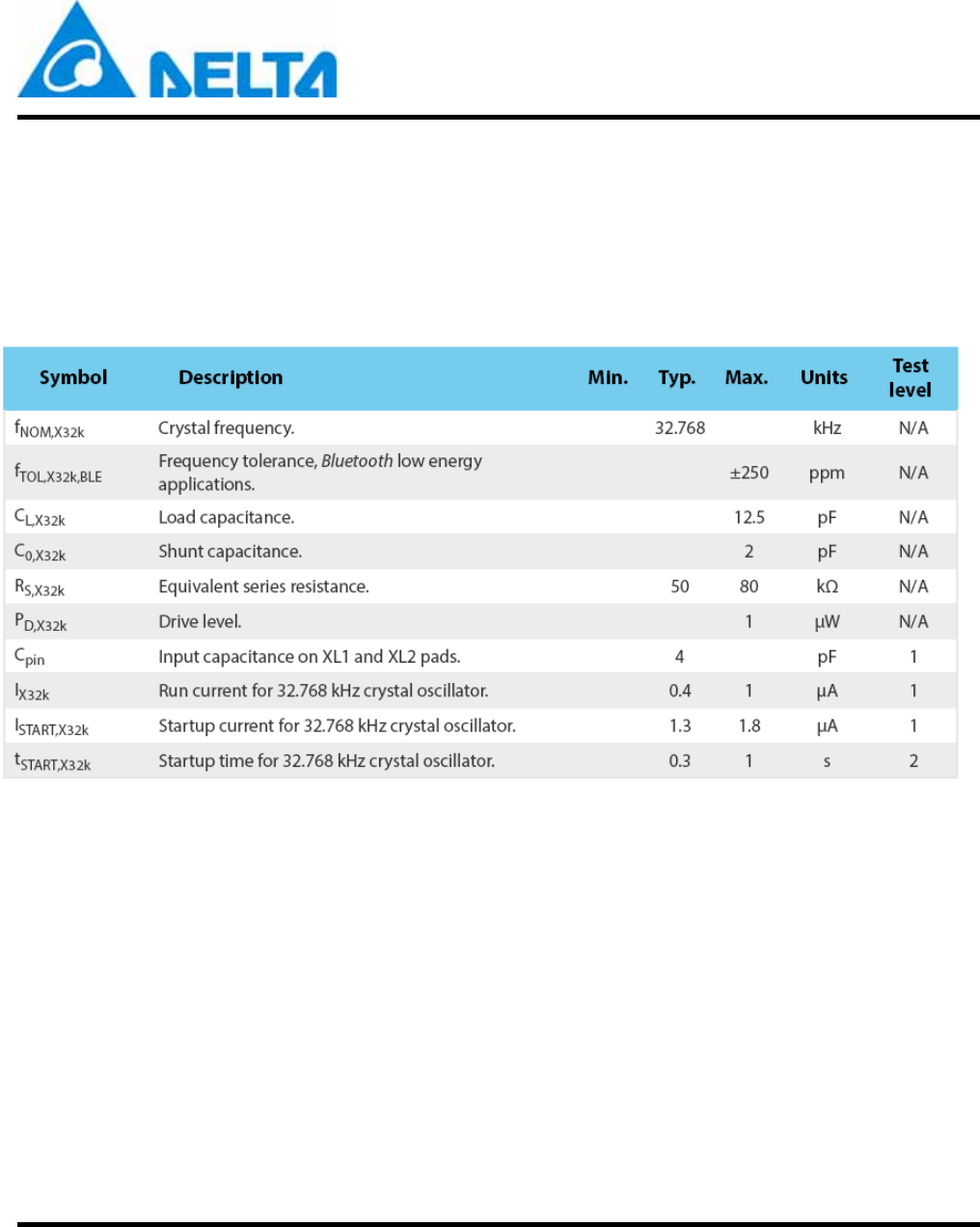
DFCM-NNN50-DT0R
Preliminary Data Sheet Sheet 16 of 41 Jun 27 2017
Proprietary Information and Specifications are Subject to Change
8. Slow Clock Requirement
8-1. External 32.768KHz crystal oscillator
The 32.768 kHz crystal oscillator is designed for use with a quartz crystal in parallel resonant mode. To
achieve correct oscillation frequency, the load capacitance must match the specification in the crystal
data sheet. Table 8-1 shows the specification of 32.768 kHz crystal oscillator.
Table 8-1 32.768 kHz crystal oscillator specification
8-2. 32.768KHz RC oscillator
The 32.768 kHz RC low frequency oscillator may be used as an alternative to the 32.768 kHz crystal
oscillator. It has a frequency accuracy of less than ± 250 ppm in a stable temperature environment or
when calibration is periodically performed in changing temperature environments. The 32.768 kHz RC
oscillator does not require external components.
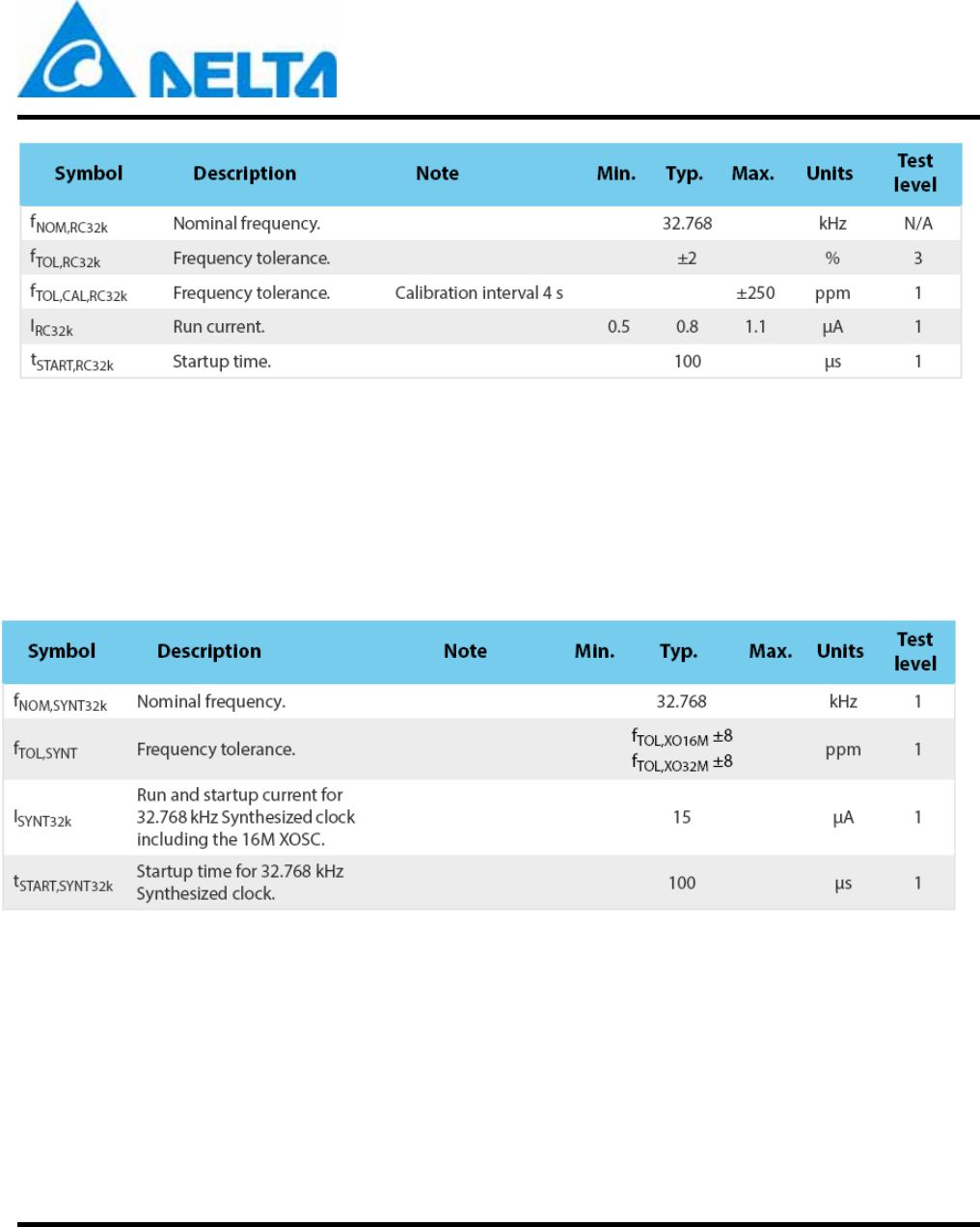
DFCM-NNN50-DT0R
Preliminary Data Sheet Sheet 17 of 41 Jun 27 2017
Proprietary Information and Specifications are Subject to Change
Table 8-2 32.768 kHz RC oscillator specification
8-3. 32.768KHz synthesized oscillator
The low frequency clock can be synthesized from the high frequency clock. This saves the cost of a
crystal but increases average power consumption as the high frequency clock source will have to be
active.
Table 8-3 32.768 kHz synthesized oscillator specification
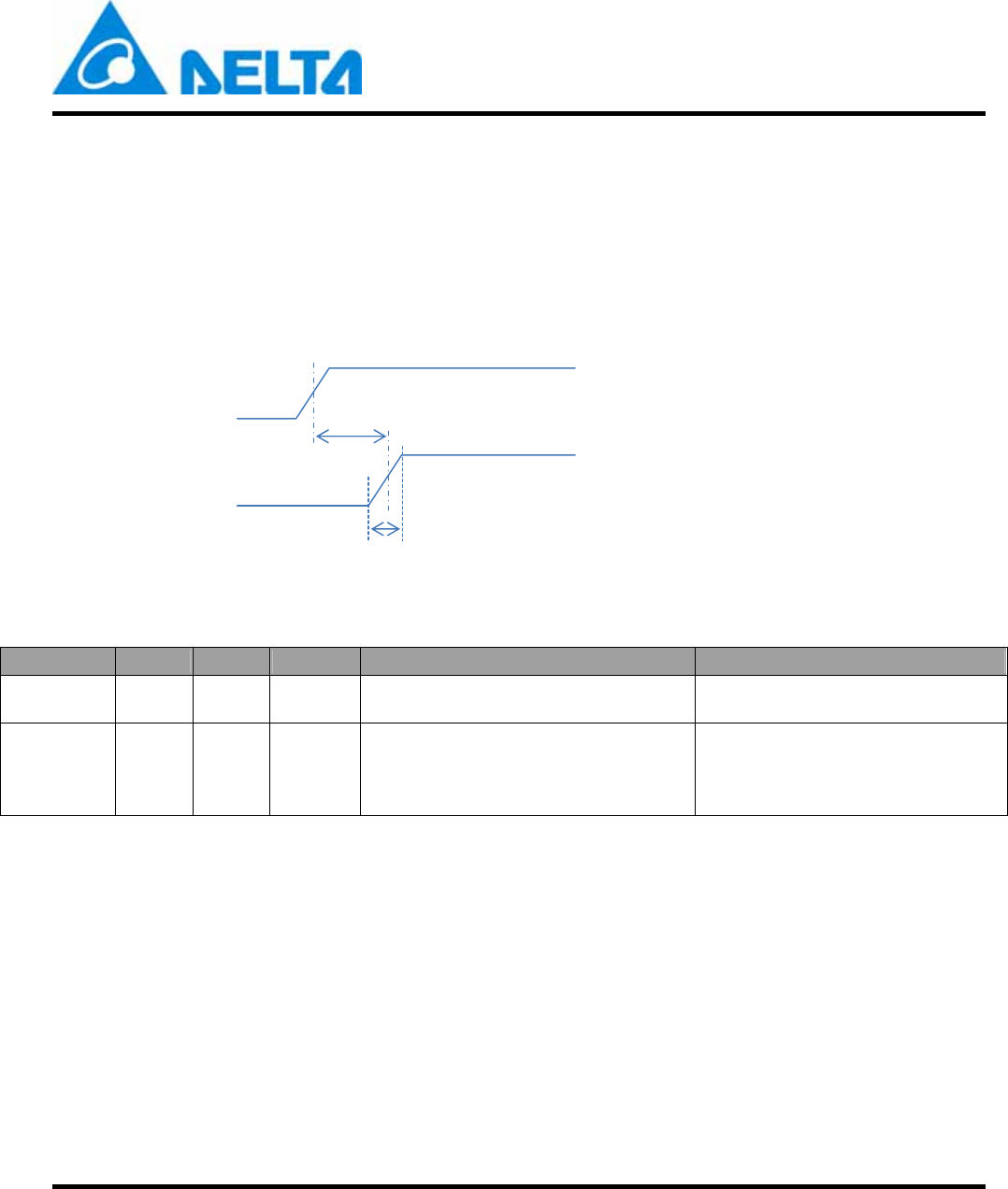
DFCM-NNN50-DT0R
Preliminary Data Sheet Sheet 18 of 41 Jun 27 2017
Proprietary Information and Specifications are Subject to Change
9. Power-Up Sequence
Power-Up Sequence
The power-up sequence for DFCM-NNN50-DT0R is shown in Figure 9.1 The timing parameters are
provided in Table 9.1
Figure 9.1 Power-Up Sequence
Parameter Min Max Units Description Notes
tB 0 ms VBAT rise to VDDIO rise VBAT and VDDIO can rise
simultaneously
tR 100 ms
VDDIO supply rise time (0V to supply
voltage)
The on-chip power on reset
circuitry may not function properly
for rise times outside the specified
internal
Table 9.1 Power-Up Sequence Timing
VBAT
VDDIO
t
B
t
tR
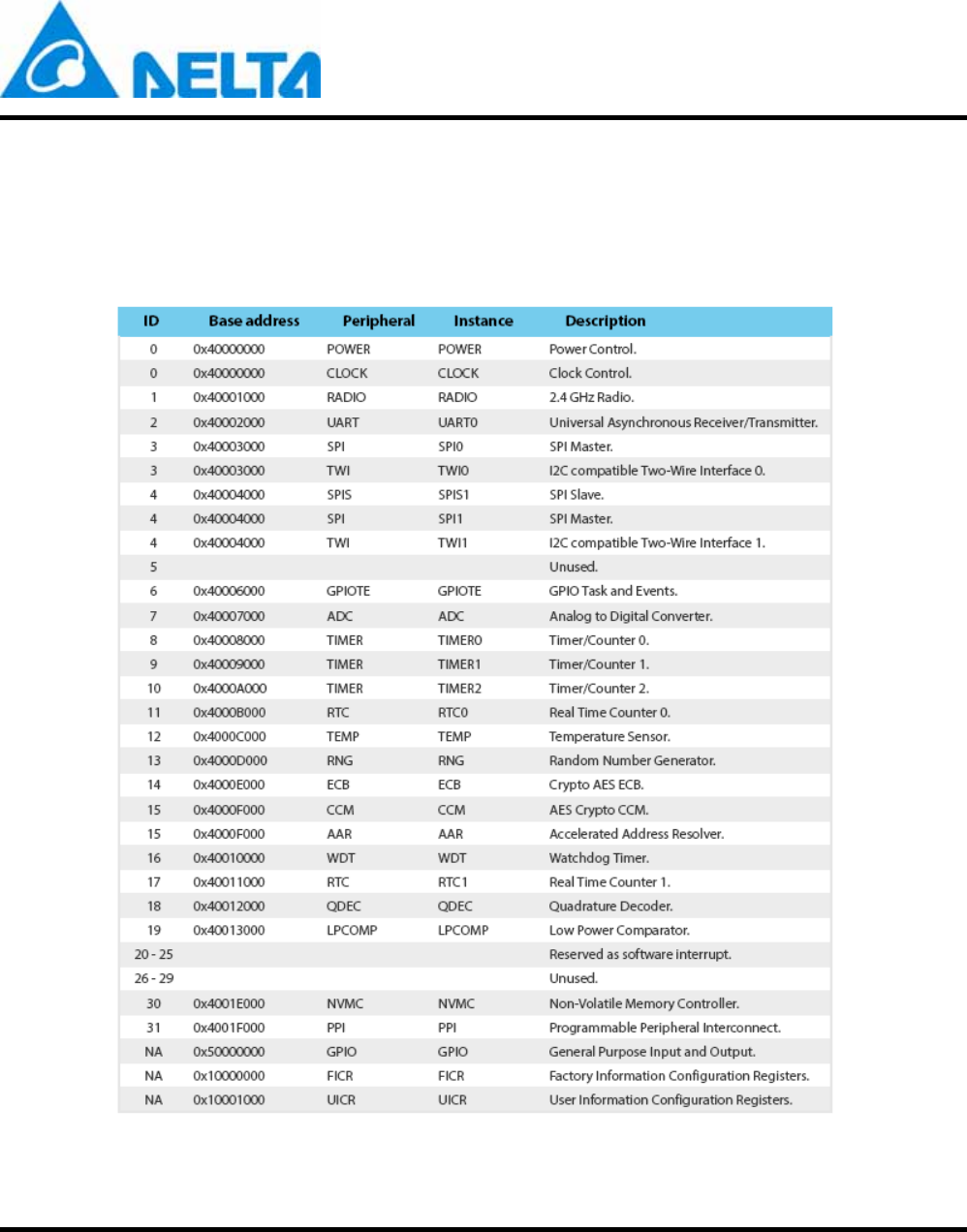
DFCM-NNN50-DT0R
Preliminary Data Sheet Sheet 19 of 41 Jun 27 2017
Proprietary Information and Specifications are Subject to Change
10. Peripheral
Peripheral blocks which have a register interface and/or interrupt vector assigned are instantiated, one
or more times, in the device address space. The instances, associated ID (for those with interrupt
vectors), and base address of features are found in Table 10-1.
Table 10-1 Peripheral instance reference
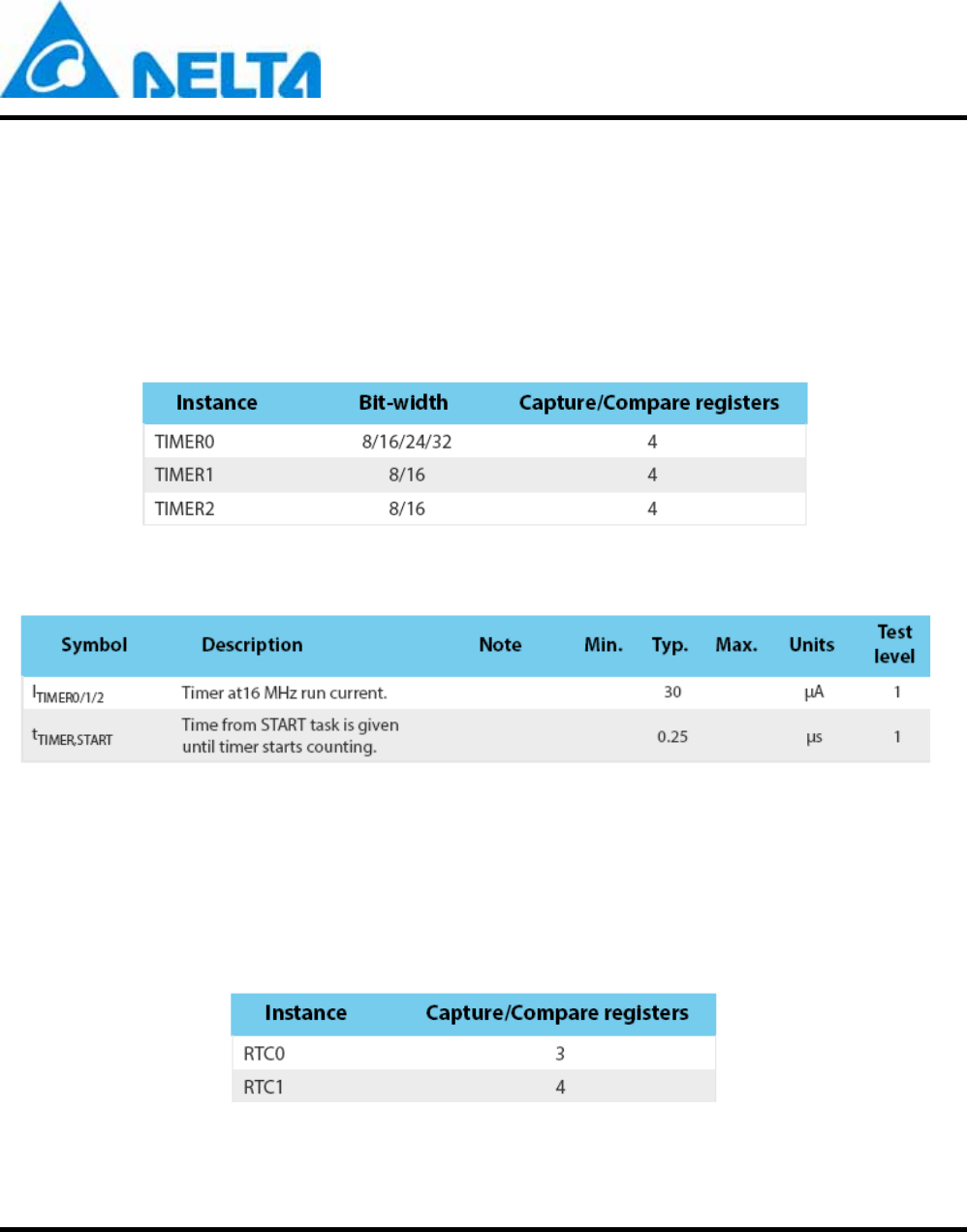
DFCM-NNN50-DT0R
Preliminary Data Sheet Sheet 20 of 41 Jun 27 2017
Proprietary Information and Specifications are Subject to Change
10-1. Timer/Counters (TIMER)
The timer/counter runs on the high-frequency clock source (HFCLK) and includes a 4 bit (1/2X)
prescaler that can divide the HFCLK.
The task/event and interrupt features make it possible to use the PPI system for timing and counting
tasks between any system peripheral including any GPIO of the device. The PPI system also enables
the TIMER task/event features to generate periodic output and PWM signals to any GPIO. The number
of input/outputs used at the same time is limited by the number of GPIOTE channels.
Table 10-2 Timer/Counter properties
Table 10-3 Timer specification
10-2. Real Time Counter (RTC)
The Real Time Counter (RTC) module provides a generic, low power timer on the low-frequency clock
source(LFCLK). The RTC features a 24 bit COUNTER, 12 bit (1/X) prescaler, capture/compare registers,
and a tick event generator for low power, tickless RTOS implementation.
Table 10-4 RTC properties
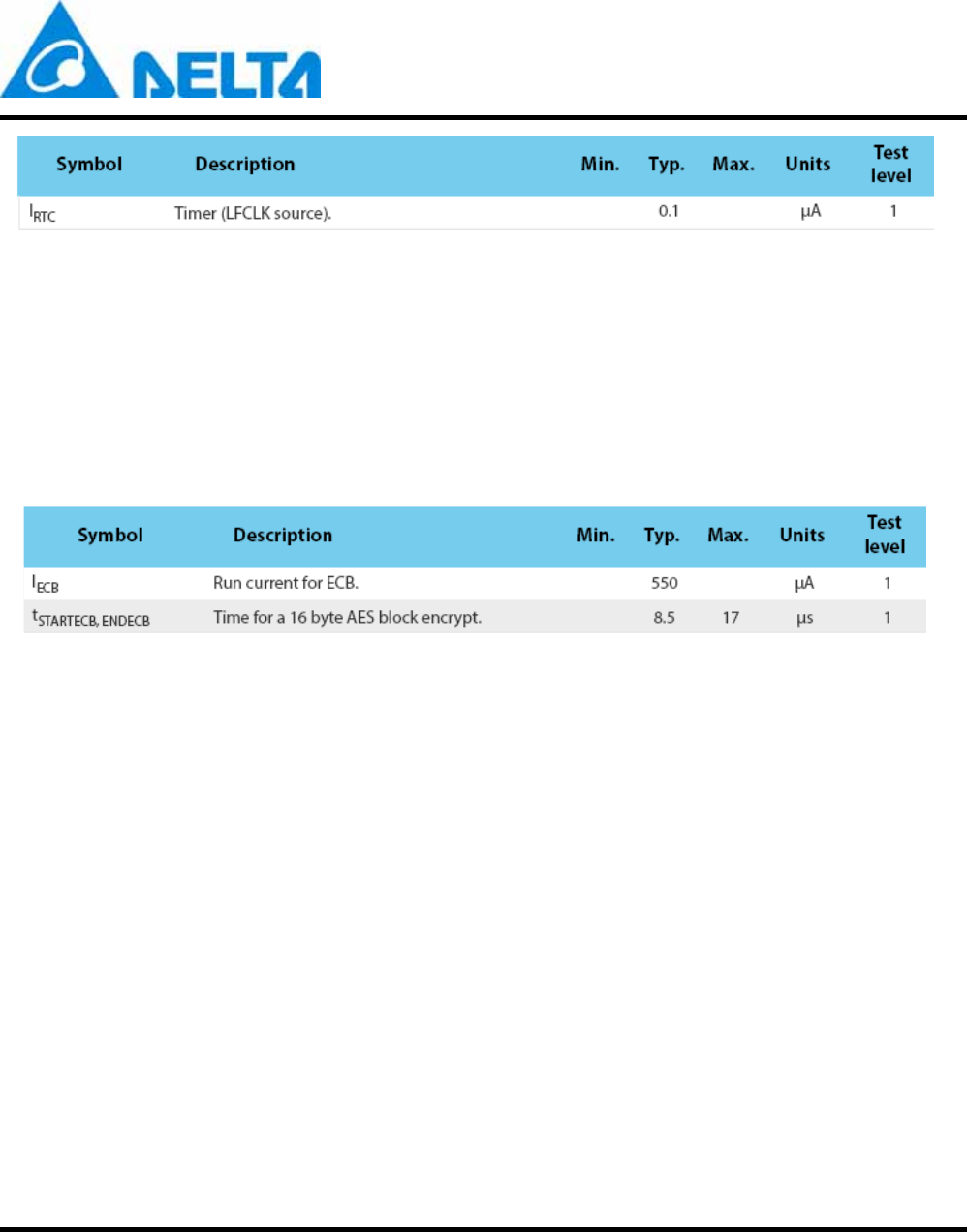
DFCM-NNN50-DT0R
Preliminary Data Sheet Sheet 21 of 41 Jun 27 2017
Proprietary Information and Specifications are Subject to Change
Table 10-5 RTC specification
10-3. AES Electronic Codebook Mode Encryption (ECB)
The ECB encryption block supports 128 bit AES block encryption. It can be used for a range of
cryptographic functions like hash generation, digital signatures, and keystream generation for data
encryption/decryption. ECB encryption uses EasyDMA to access system RAM for in-place operations
on cleartext and ciphertext during encryption.
Table 10-6 ECB specification
10-4. AES CCM Mode Encryption (CCM)
Cipher Block Chaining - Message Authentication Code (CCM) Mode is an authenticated encryption
algorithm designed to provide both authentication and confidentiality during data transfer. CCM
combines counter mode encryption and CBC-MAC authentication.
Note: The CCM terminology "Message Authentication Code (MAC)" is called the "Message Integrity
Check (MIC)" in Bluetooth terminology.
The CCM block generates an encrypted keystream, applies it to the input data using the XOR operation,
and generates the 4 byte MIC field in one operation. The CCM and radio can be configured to work
synchronously. The CCM will encrypt in time for transmission and decrypt after receiving bytes into
memory from the Radio. All operations can complete within the packet RX or TX time.
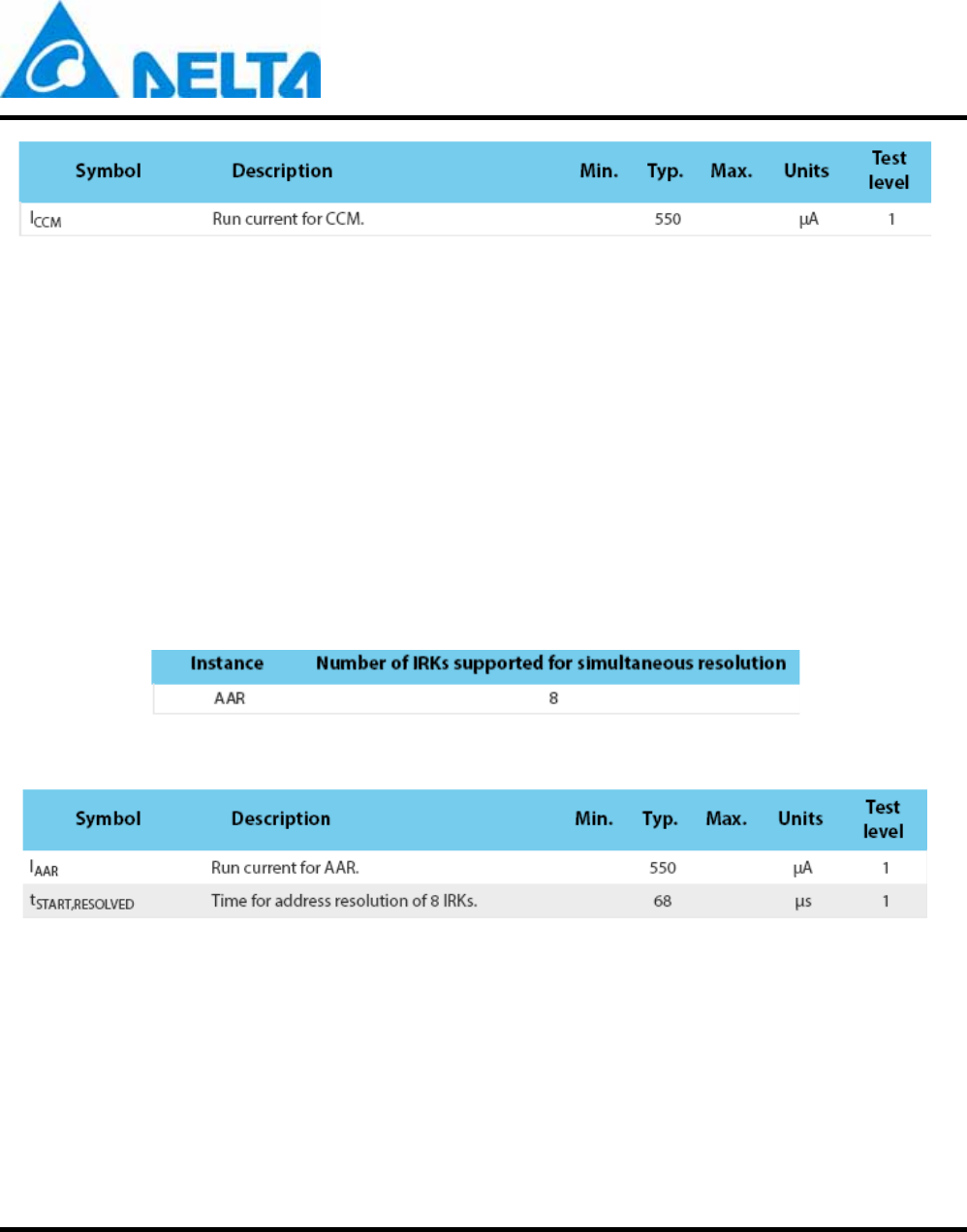
DFCM-NNN50-DT0R
Preliminary Data Sheet Sheet 22 of 41 Jun 27 2017
Proprietary Information and Specifications are Subject to Change
Table 10-7 CCM specification
10-5. Accelerated Address Resolver (AAR)
Accelerated Address Resolver is a cryptographic support function to implement the "Resolvable Private
Address Resolution Procedure" described in the Bluetooth Core Specification v4.0. "Resolvable Private
Address Generation" should be achieved using ECB and is not supported by AAR. The procedure
allows two devices that share a secret key to generate and resolve a hash based on their device
address.
The AAR block enables real-time address resolution on incoming packets. This allows real-time packet
filtering (whitelisting) using a list of known shared secrets (Identity Resolving Keys (IRK) in Bluetooth).
The following table outlines the properties of the AAR.
Table 10-8 AAR properties
Table 10-9 AAR specification
10-6. Random Number Generator (RNG)
The Random Number Generator (RNG) generates true non-deterministic random numbers derived from
thermal noise that are suitable for cryptographic purposes. The RNG does not require a seed value.
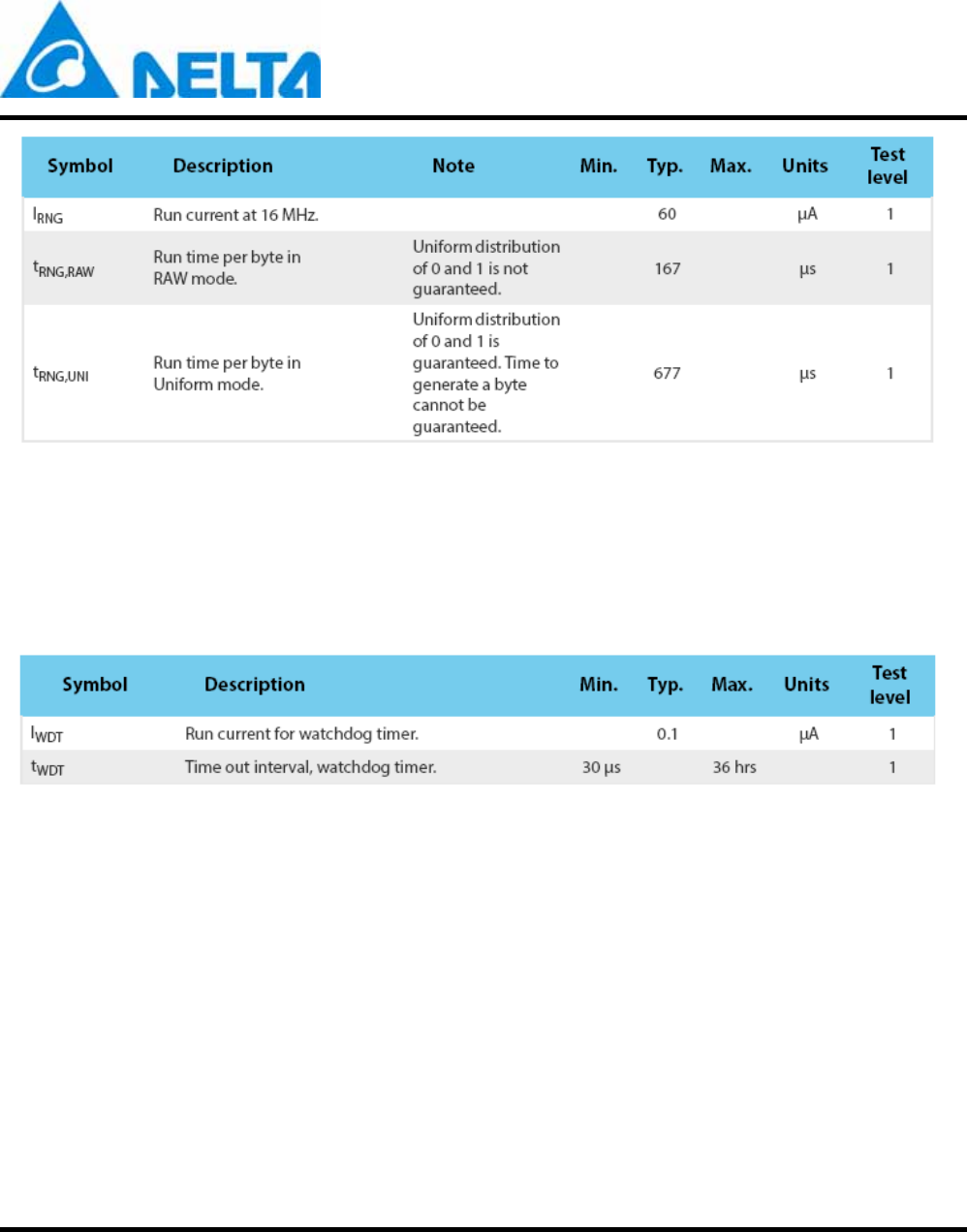
DFCM-NNN50-DT0R
Preliminary Data Sheet Sheet 23 of 41 Jun 27 2017
Proprietary Information and Specifications are Subject to Change
Table 10-10 Random Number Generator (RNG) specifications
10-7. Watchdog Timer (WDT)
A countdown watchdog timer using the low-frequency clock source (LFCLK) offers configurable and
robust protection against application lock-up. The watchdog can be paused during long CPU sleep
periods for low power applications and when the debugger has halted the CPU.
Table 10-11 Watchdog Timer specifications
10-8. Temperature sensor (TEMP)
The temperature sensor measures die temperature over the temperature range of the device with 0.25°
C resolution.
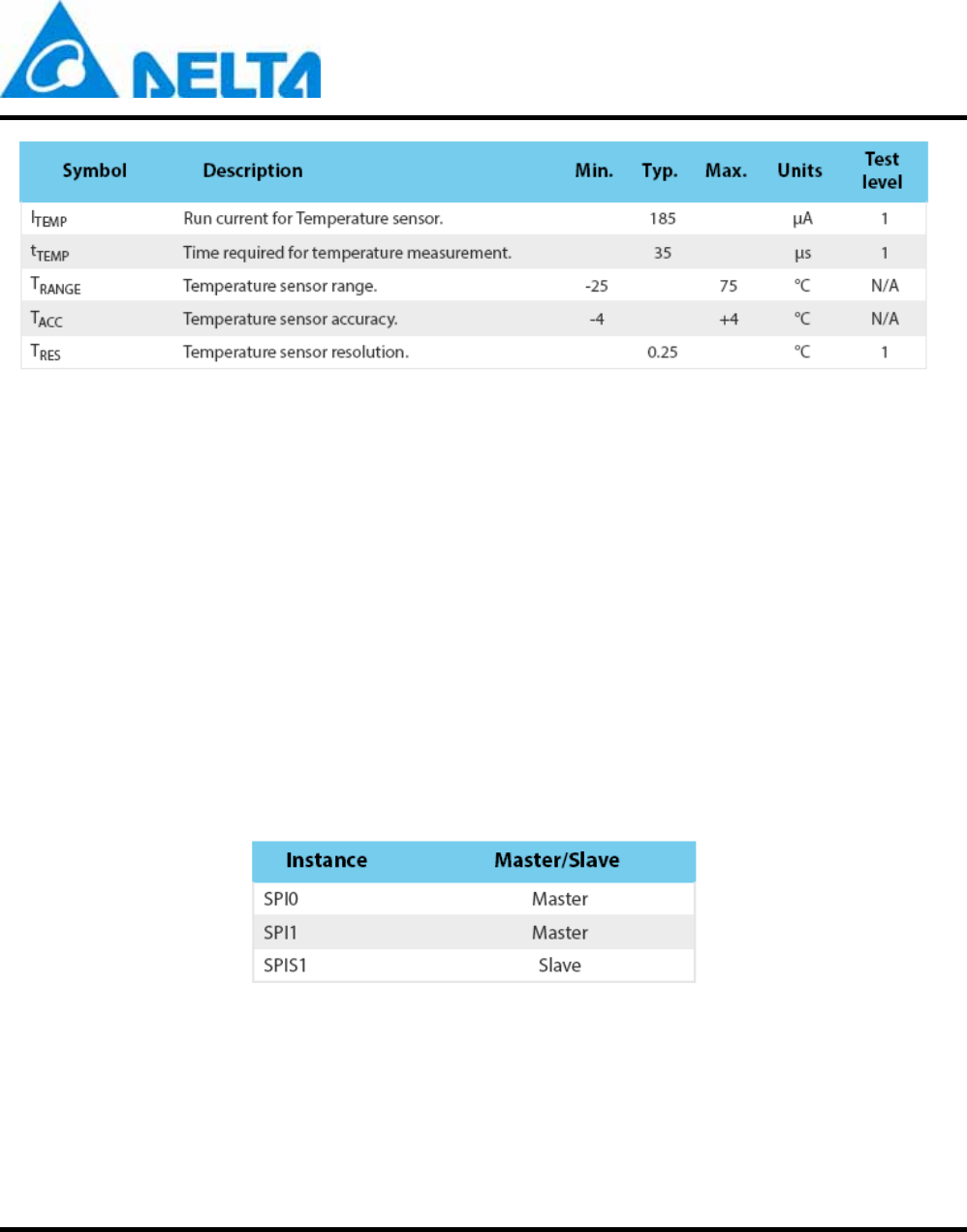
DFCM-NNN50-DT0R
Preliminary Data Sheet Sheet 24 of 41 Jun 27 2017
Proprietary Information and Specifications are Subject to Change
Table 10-12 Temperature sensor
10-9. BLE Serial Peripheral Interface (SPIS/SPI)
The SPI interfaces enable full duplex synchronous communication between devices. They support a
threewire (SCK, MISO, MOSI) bi-directional bus with fast data transfers. The SPI Master can
communicate with multiple slaves using individual chip select signals for each of the slave devices
attached to a bus. Control of chip select signals is left to the application through use of GPIO signals.
SPI Master has double buffered I/O data. The SPI Slave includes EasyDMA for data transfer directly to
and from RAM allowing Slave data transfers to occur while the CPU is IDLE.
The GPIOs used for each SPI interface line can be chosen from any GPIO on the device and are
independently configurable. This enables great flexibility in device pinout and efficient use of printed
circuit board space and signal routing.
The SPI peripheral supports SPI mode 0, 1, 2, and 3.
Table 10-13 SPI properties
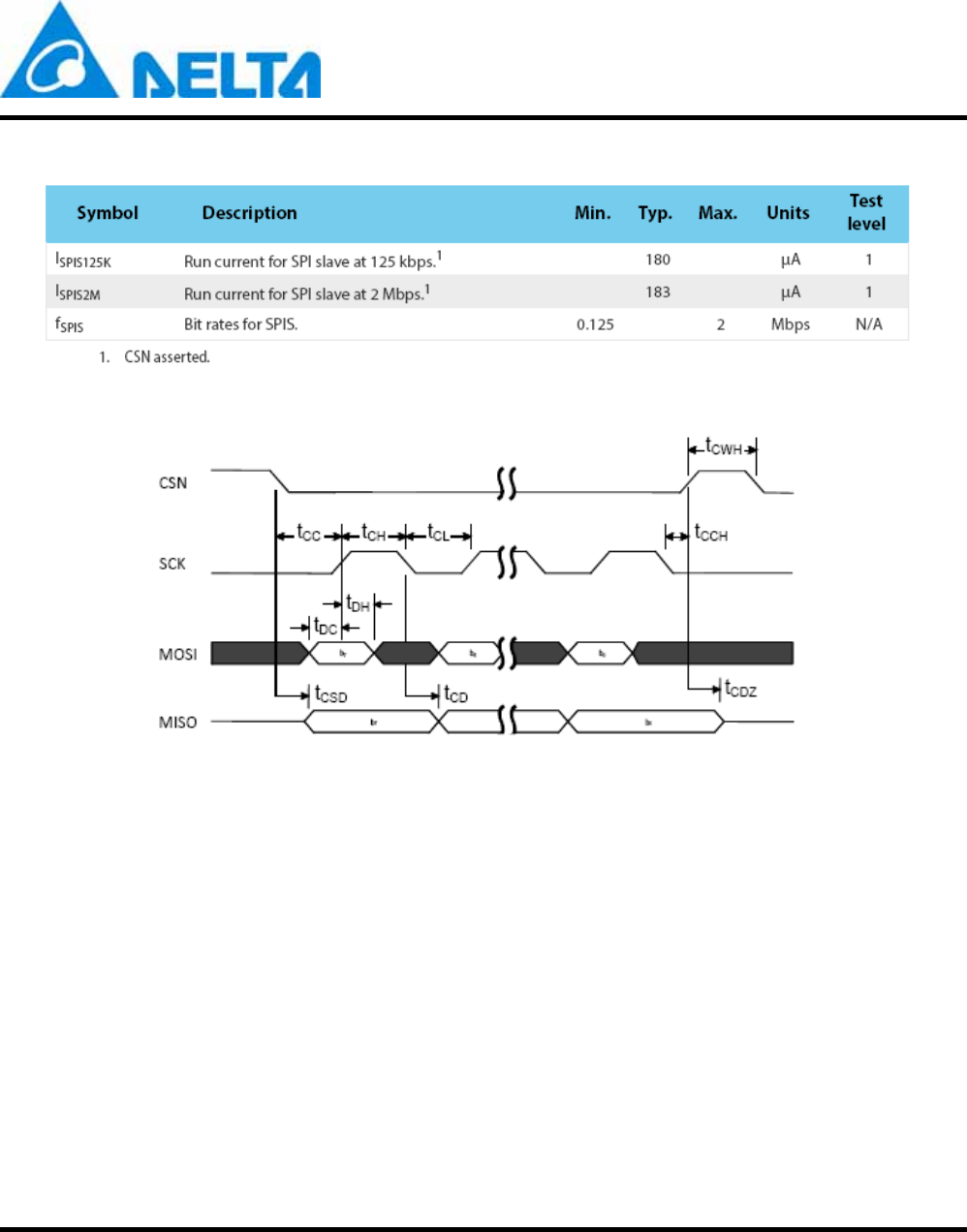
DFCM-NNN50-DT0R
Preliminary Data Sheet Sheet 25 of 41 Jun 27 2017
Proprietary Information and Specifications are Subject to Change
10-9.1.SPI Slave Specifications and Parameters
Table 10-14. SPIS specifications
Figure 10-1 SPIS timing diagram, one byte transmission, SPI Mode 0
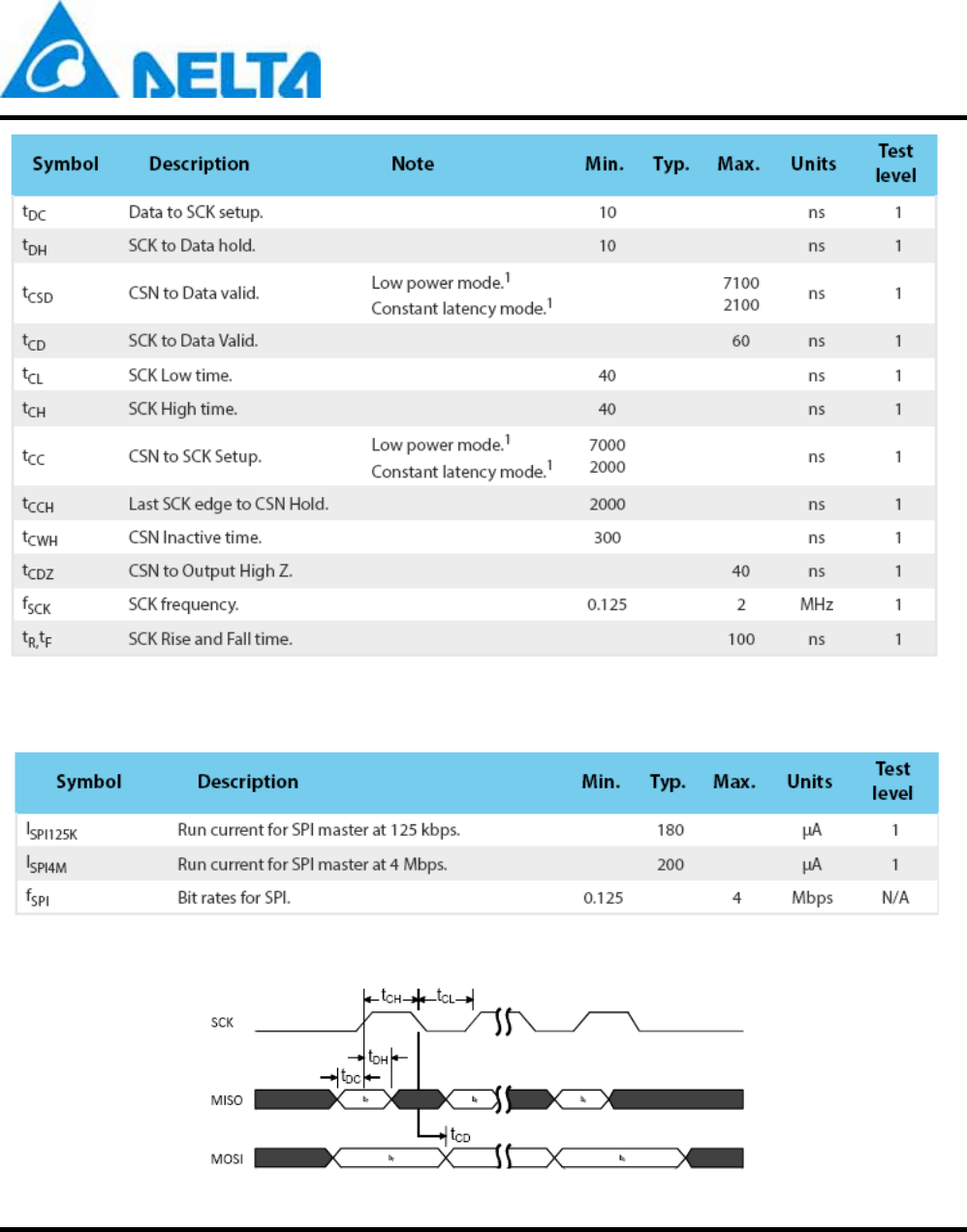
DFCM-NNN50-DT0R
Preliminary Data Sheet Sheet 26 of 41 Jun 27 2017
Proprietary Information and Specifications are Subject to Change
Table 10-15 SPIS timing parameters
10-9.2.SPI Master Specifications and Parameters
Table 10-16 SPI specifications
Figure 10-2 SPI timing diagram, one byte transmission, SPI Mode 0
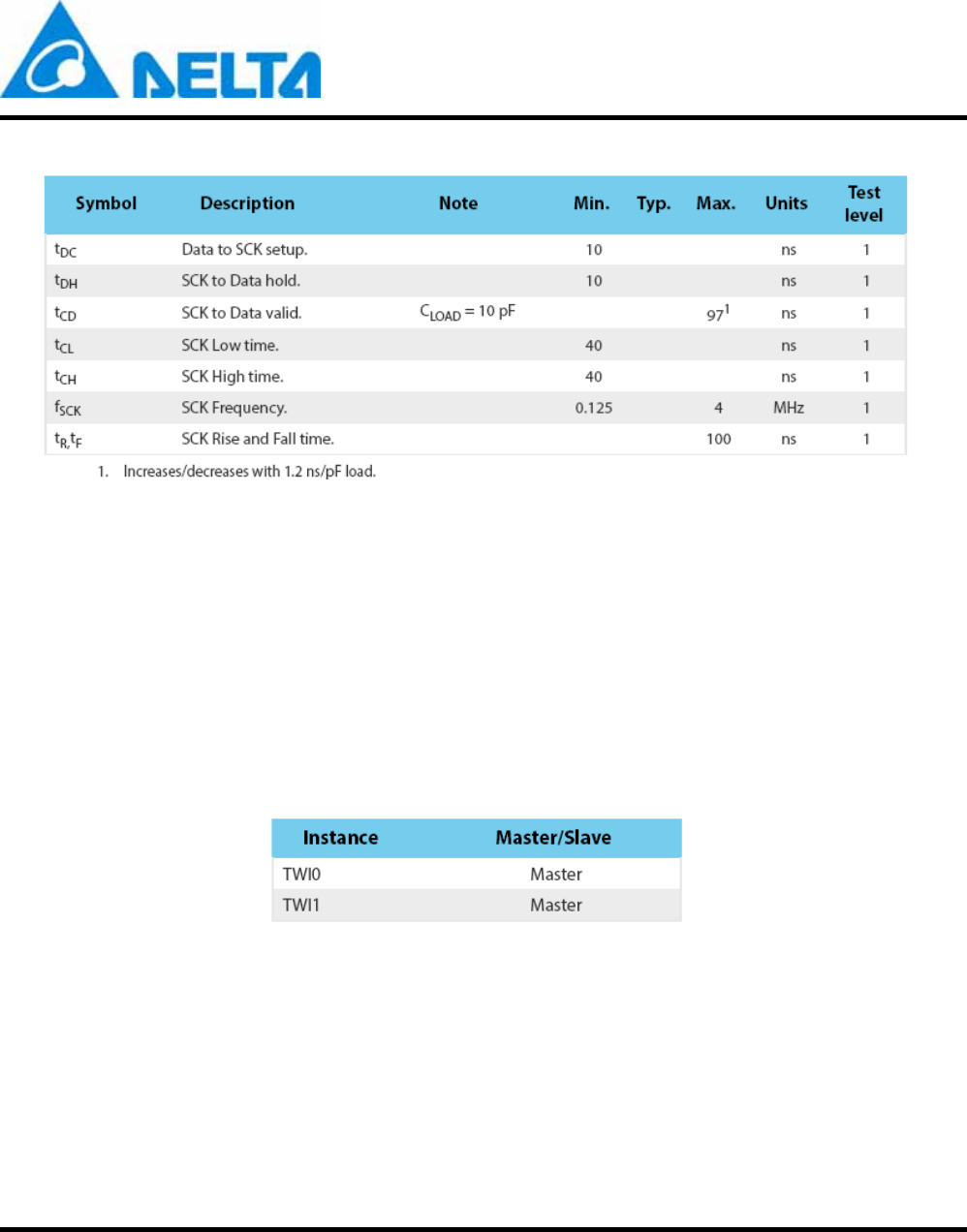
DFCM-NNN50-DT0R
Preliminary Data Sheet Sheet 27 of 41 Jun 27 2017
Proprietary Information and Specifications are Subject to Change
Table 10-17 SPI timing parameters
10-10. Two-wire interface (TWI)
The two-wire interface can communicate with a bi-directional wired-AND bus with two lines (SCL, SDA).
The protocol makes it possible to interconnect up to 127 individually addressable devices. The interface
is capable of clock stretching, supporting data rates of 100 kbps and 400 kbps.
The GPIOs used for each two-wire interface line can be chosen from any GPIO on the device and are
independently configurable. This enables great flexibility in device pinout and efficient use of board
space and signal routing
Table 10-18 Two-wire properties
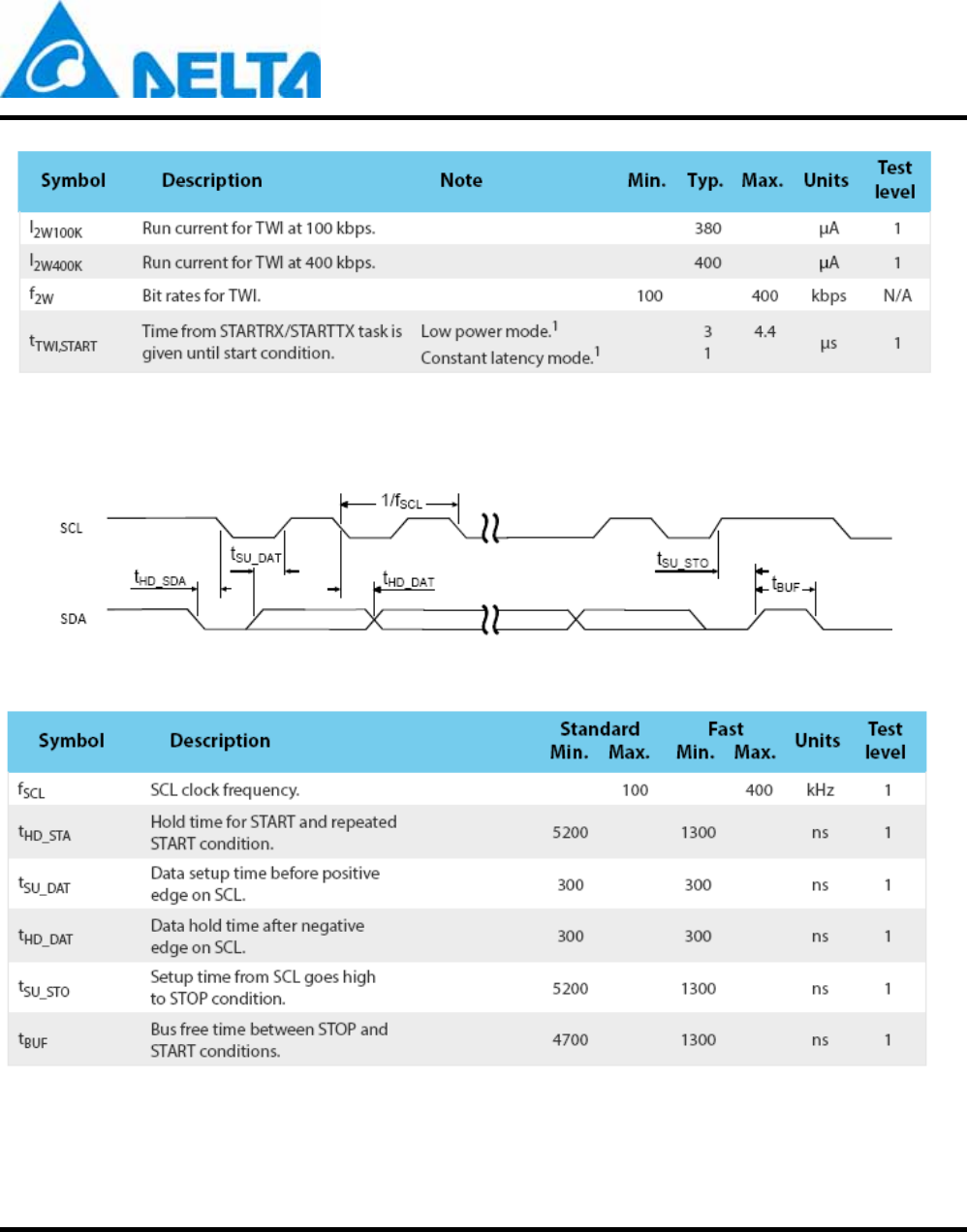
DFCM-NNN50-DT0R
Preliminary Data Sheet Sheet 28 of 41 Jun 27 2017
Proprietary Information and Specifications are Subject to Change
Table 10-19 TWI specification
Figure 10-3 SCL/SDA timing
Table 10-20 TWI timing parameters
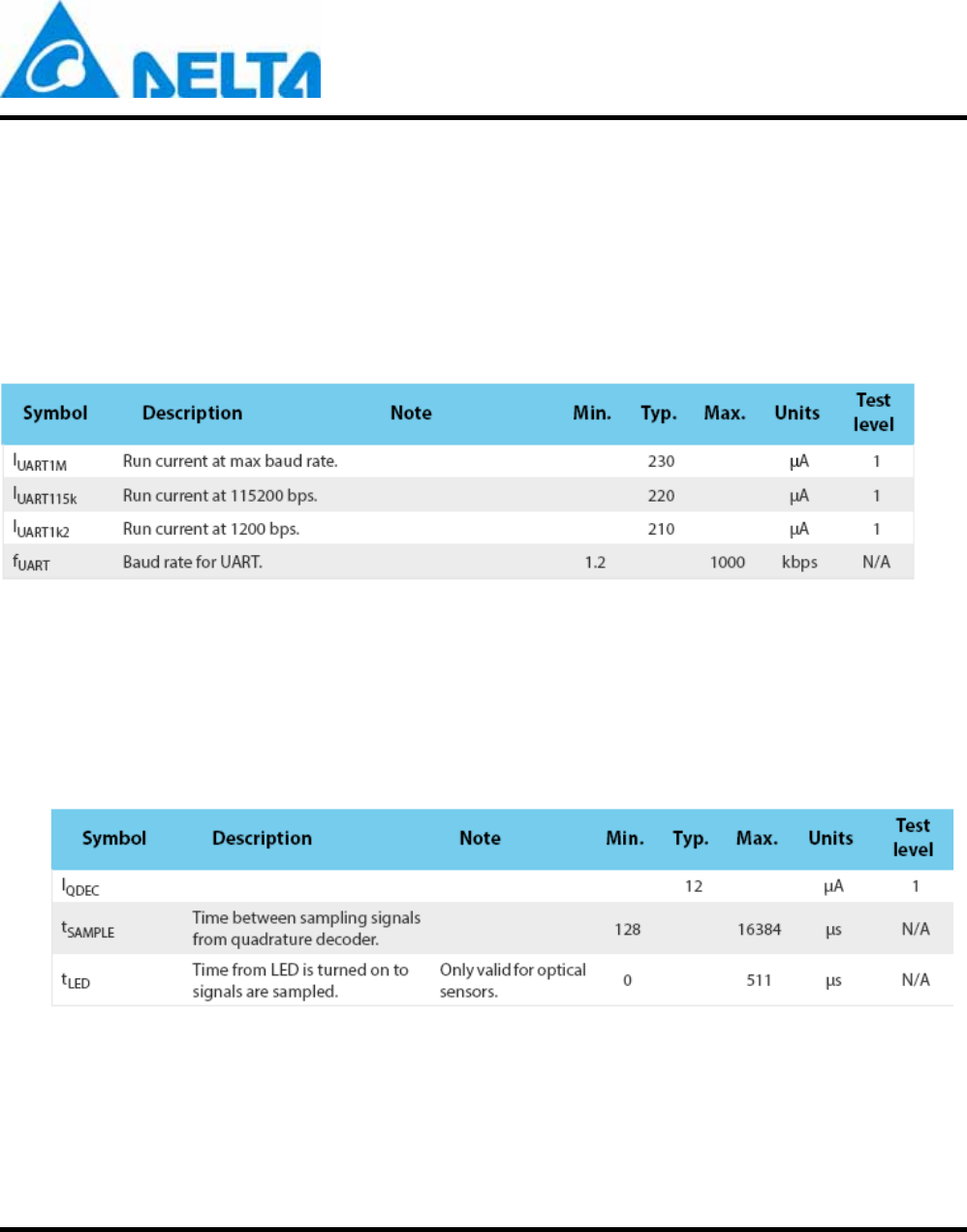
DFCM-NNN50-DT0R
Preliminary Data Sheet Sheet 29 of 41 Jun 27 2017
Proprietary Information and Specifications are Subject to Change
10-11. Universal Asynchronous Receiver/Transmitter (UART)
The Universal Asynchronous Receiver/Transmitter offers fast, full-duplex, asynchronous serial
communication with built-in flow control (CTS, RTS) support in hardware up to 1 Mbps baud. Parity
checking is supported.
The GPIOs used for each UART interface line can be chosen from any GPIO on the device and are
independently configurable. This enables great flexibility in device pinout and efficient use of board
space and signal routing.
Table 10-21 UART specifications
10-12. Quadrature Decoder (QDEC)
The quadrature decoder provides buffered decoding of quadrature-encoded sensor signals. It is suitable
for mechanical and optical sensors with an optional LED output signal and input debounce filters. The
sample period and accumulation are configurable to match application requirements.
Table 10-22 Quadrature Decoder specifications
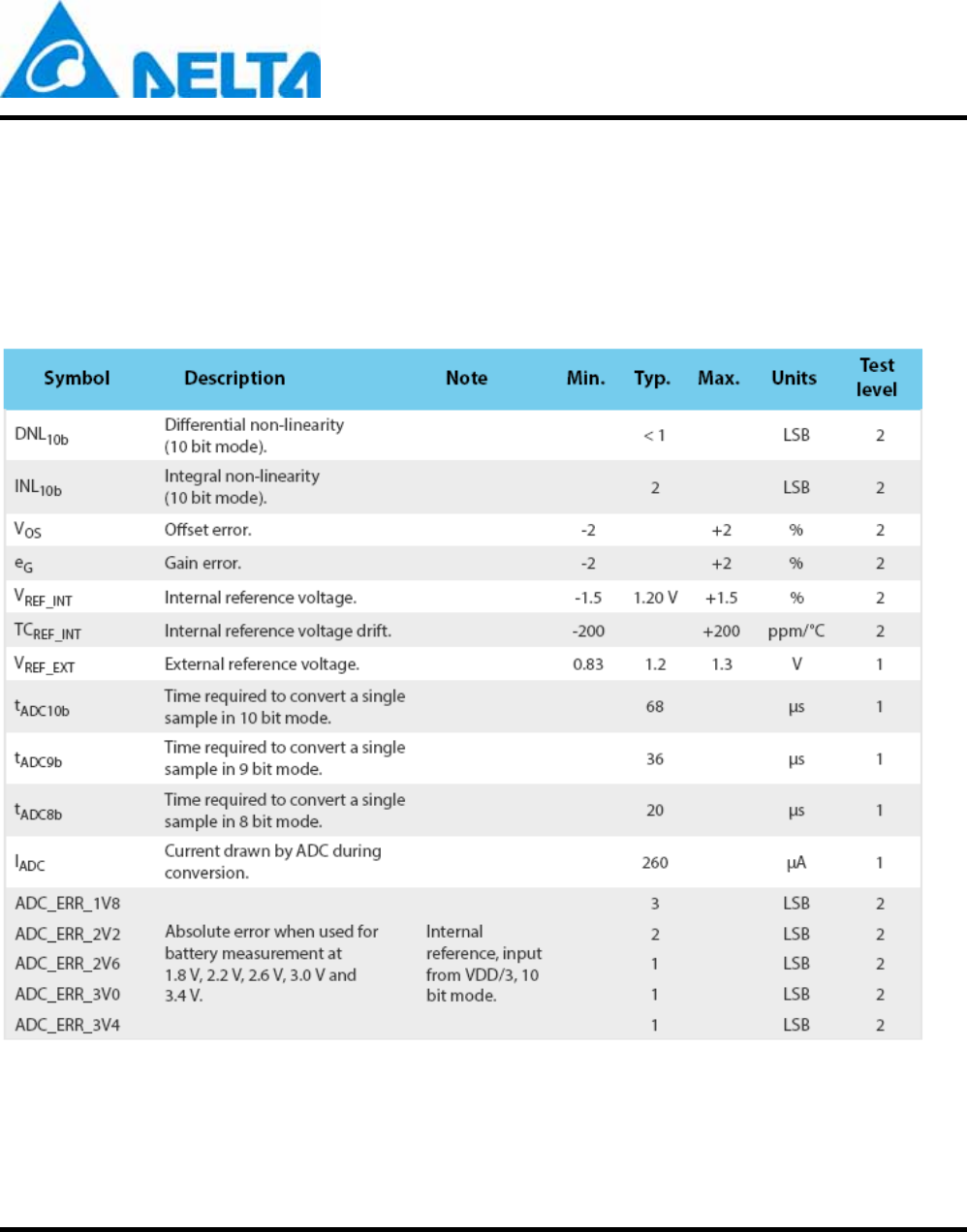
DFCM-NNN50-DT0R
Preliminary Data Sheet Sheet 30 of 41 Jun 27 2017
Proprietary Information and Specifications are Subject to Change
10-13. Analog to Digital Converter (ADC)
The 10 bit incremental Analog to Digital Converter (ADC) enables sampling of up to 5 external signals
through a front-end multiplexer. The ADC has configurable input and reference prescaling, and sample
resolution (8, 9, and 10 bit).
Note: The ADC module uses the same analog inputs as the LPCOMP module (AIN0, AIN1, AIN5, AIN6,
AIN07, and AREF1). Only one of the modules can be enabled at the same time.
Table 10-23 Analog to Digital Converter (ADC) specifications
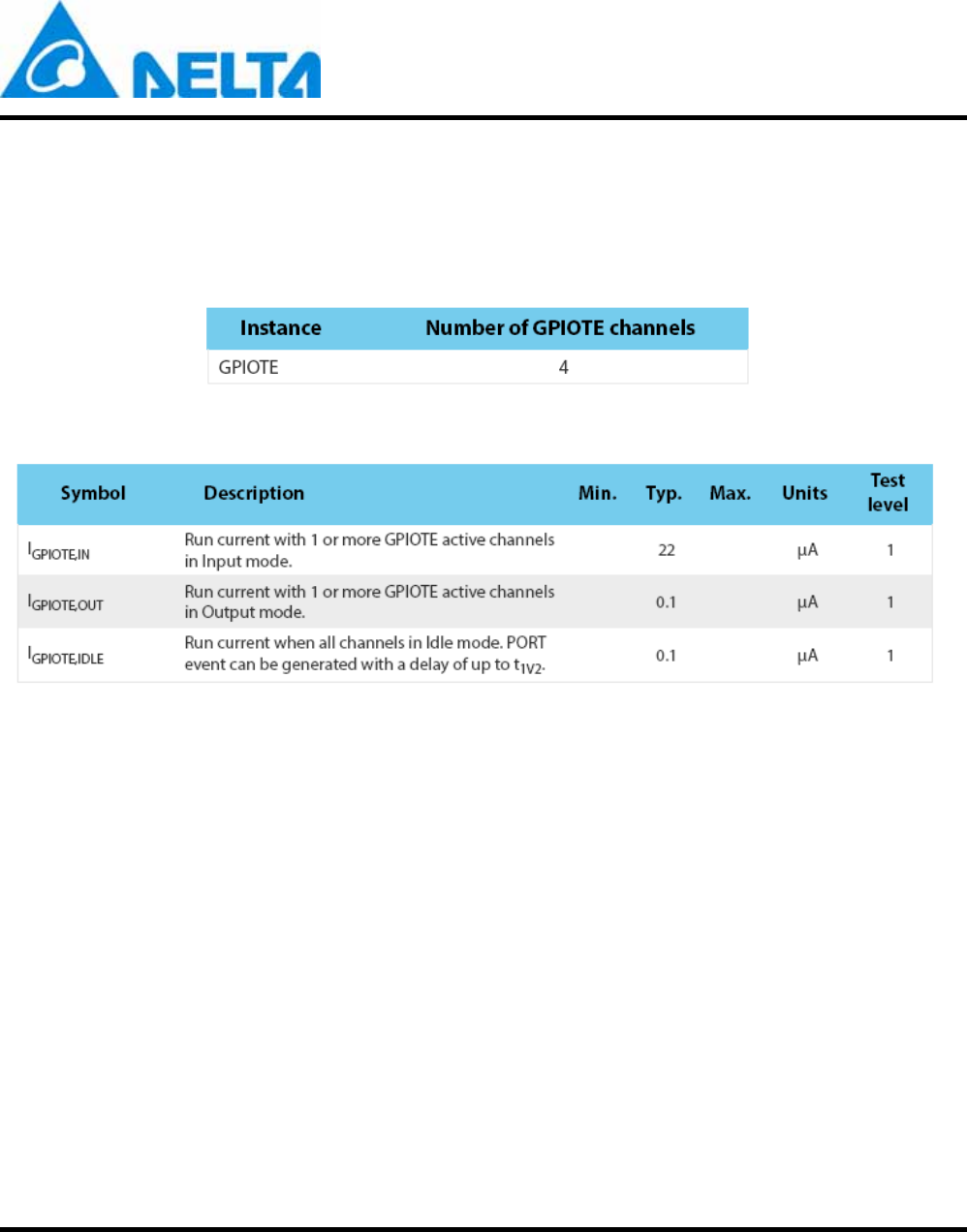
DFCM-NNN50-DT0R
Preliminary Data Sheet Sheet 31 of 41 Jun 27 2017
Proprietary Information and Specifications are Subject to Change
10-14. GPIO Task Event block (GPIOTE)
A GPIOTE block enables GPIOs on Port 0 to generate events on pin state change which can be used to
carry out tasks through the PPI system. A GPIO can also be driven to change state on system events
using the PPI system. Low power detection of pin state changes on Port 0 is possible when in System
ON or System OFF.
Table 10-24 GPIOTE properties
Table 10-25 GPIOTE specification
Note: Setting up one or more GPIO DETECT signals to generate PORT EVENT, which can be used
either as a wakeup source or to give an interrupt, will not lead to an increase of the current
consumption.
10-15. Low Power Comparator (LPCOMP)
In System ON, the block can generate separate events on rising and falling edges of a signal, or sample
the current state of the pin as being above or below the threshold. The block can be configured to use
any of the analog inputs on the device. Additionally, the low power comparator can be used as an
analog wakeup source from System OFF or System ON. The comparator threshold can be programmed
to a range of fractions of the supply voltage.
Note: The LPCOMP module uses the same analog inputs as the ADC module (AIN0, AIN1, AIN5, AIN6,
AIN7, and AREF1). Only one of the modules can be enabled at the same time.
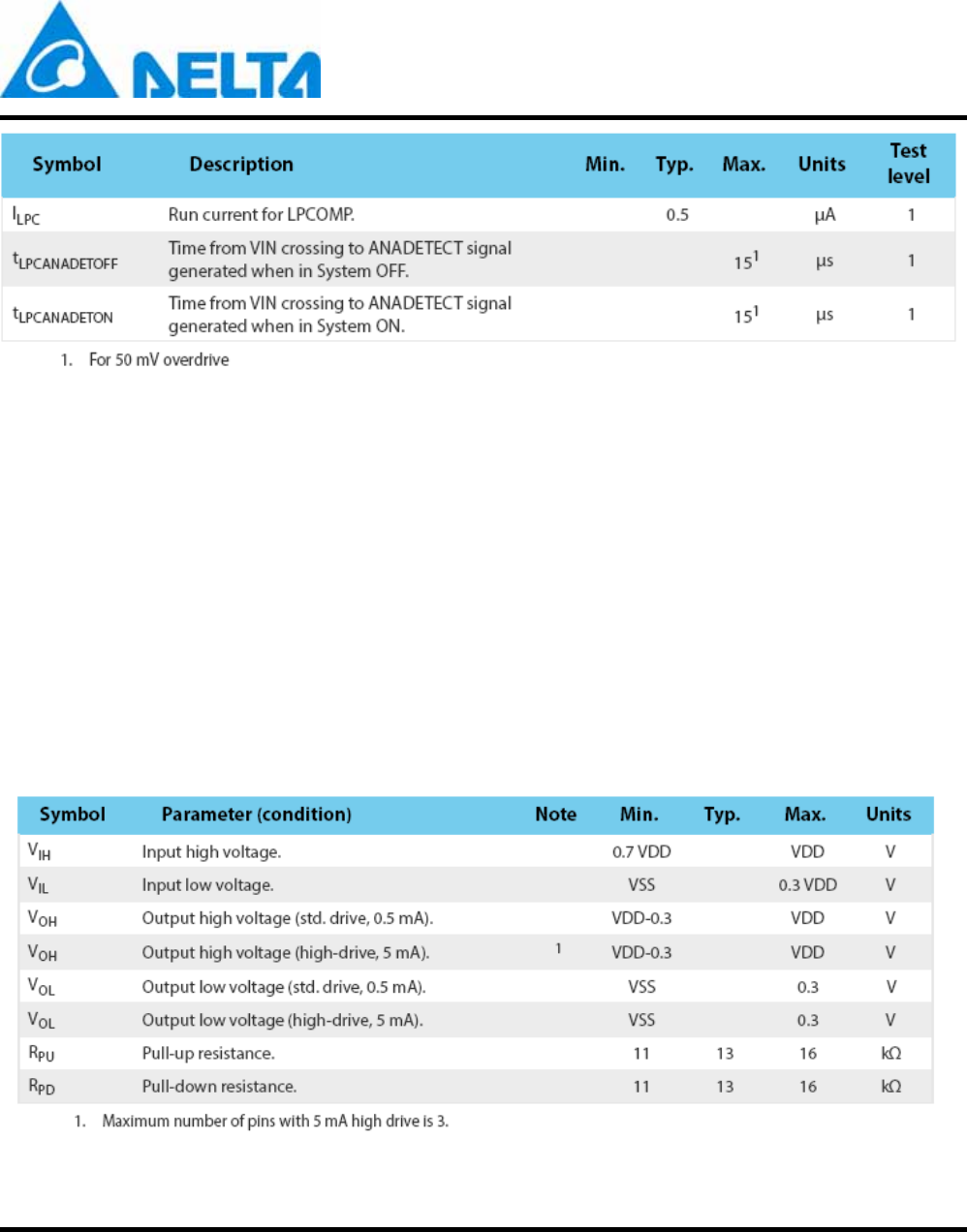
DFCM-NNN50-DT0R
Preliminary Data Sheet Sheet 32 of 41 Jun 27 2017
Proprietary Information and Specifications are Subject to Change
Table 10-26 Low power comparator specifications
10-16. GPIO
The general purpose I/O is organized as one port with up to 14 I/Os enabling. Each GPIO can be
accessed individually with the following user configurable features:
• Input/output direction
• Output drive strength
• Internal pull-up and pull-down resistors
• Wake-up from high or low level triggers on all pins
• Trigger interrupt on all pins
• All pins can be used by the PPI task/event system; the maximum number of pins that can be interfaced
through the PPI at the same time is limited by the number of GPIOTE channels
• All pins can be individually configured to carry serial interface or quadrature demodulator signals
Table 10-27 General Purpose I/O(GPIO) specifications
Note: The VDDIO is 3.3V
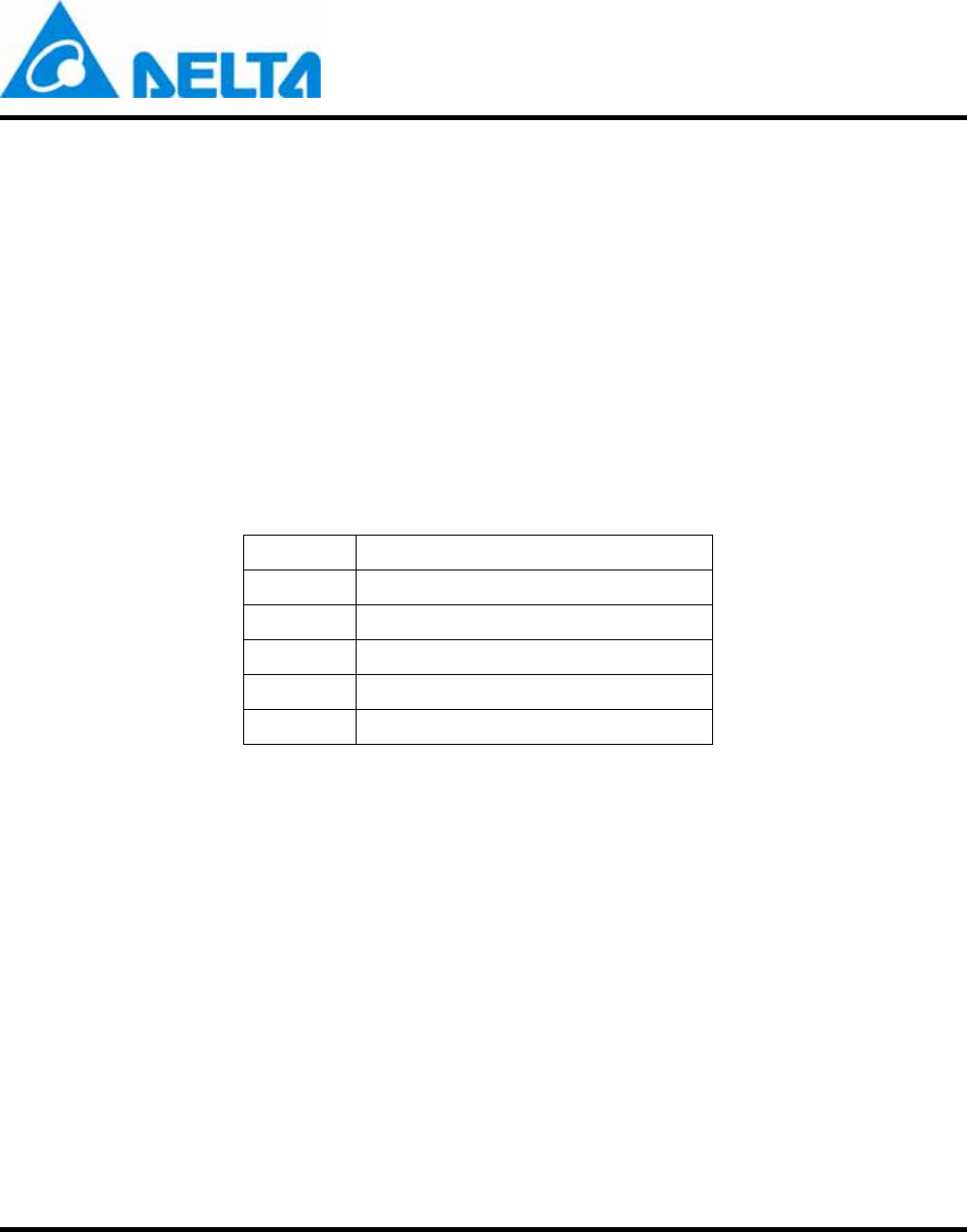
DFCM-NNN50-DT0R
Preliminary Data Sheet Sheet 33 of 41 Jun 27 2017
Proprietary Information and Specifications are Subject to Change
10-17. Debugger support
The two pin Serial Wire Debug (SWD) interface provided as a part of the Debug Access Port (DAP) in
conjunction with the Nordic Trace Buffer (NTB) offers a flexible and powerful mechanism for
non-intrusive debugging of program code. Breakpoints, single stepping, and instruction trace capture of
code execution flow are part of this support.
10-18. WLAN SPI Slave Interface
WLAN provides a Serial Peripheral Interface (SPI) that operates as a SPI slave. The SPI Slave interface
can be used for control and for serial I/O of 802.11 data. The SPI Slave pins are mapped as shown in
Table 10-28. The RXD pin is same as Master Output, Slave Input (MOSI), and the TXD pin is same as
Master Input, Slave Output (MISO). The SPI Slave is a full-duplex slave-synchronous serial interface
that is available immediately following reset when module pin 25 is tied to VDDIO.
Pin SPI Function
25 CFG: Must be tied to VDDIO
33 SSN: Active Low Slave Select
32 SCK: Serial Clock
15 RXD: Serial Data Receive (MOSI)
31 TXD: Serial Data Transmit (MISO)
Table 10-28 SPI Slave Interface Pin Mapping
When the SPI is not selected, i.e., when SSN is high, the SPI interface will not interfere with data
transfers between the serial-master and other serial-slave devices. When the serial slave is not selected,
its transmitted data output is buffered, resulting in a high impedance drive onto the serial master receive
line.
The SPI Slave interface responds to a protocol that allows an external host to read or write any register
in the chip as well as initiate DMA transfers. For the details of the SPI protocol and more specific
instructions please refer to ATWILC1000A-UU Programming Guide.
The SPI Slave interface supports four standard modes as determined by the Clock Polarity (CPOL) and
Clock Phase (CPHA) settings. These modes are illustrated in Table 10-29 and Figure 10-4. The red lines
in Figure 10-4 correspond to Clock Phase = 0 and the blue lines correspond to Clock Phase = 1.
The SPI Slave timing is provided in Figure 10-5 and Table 10-30
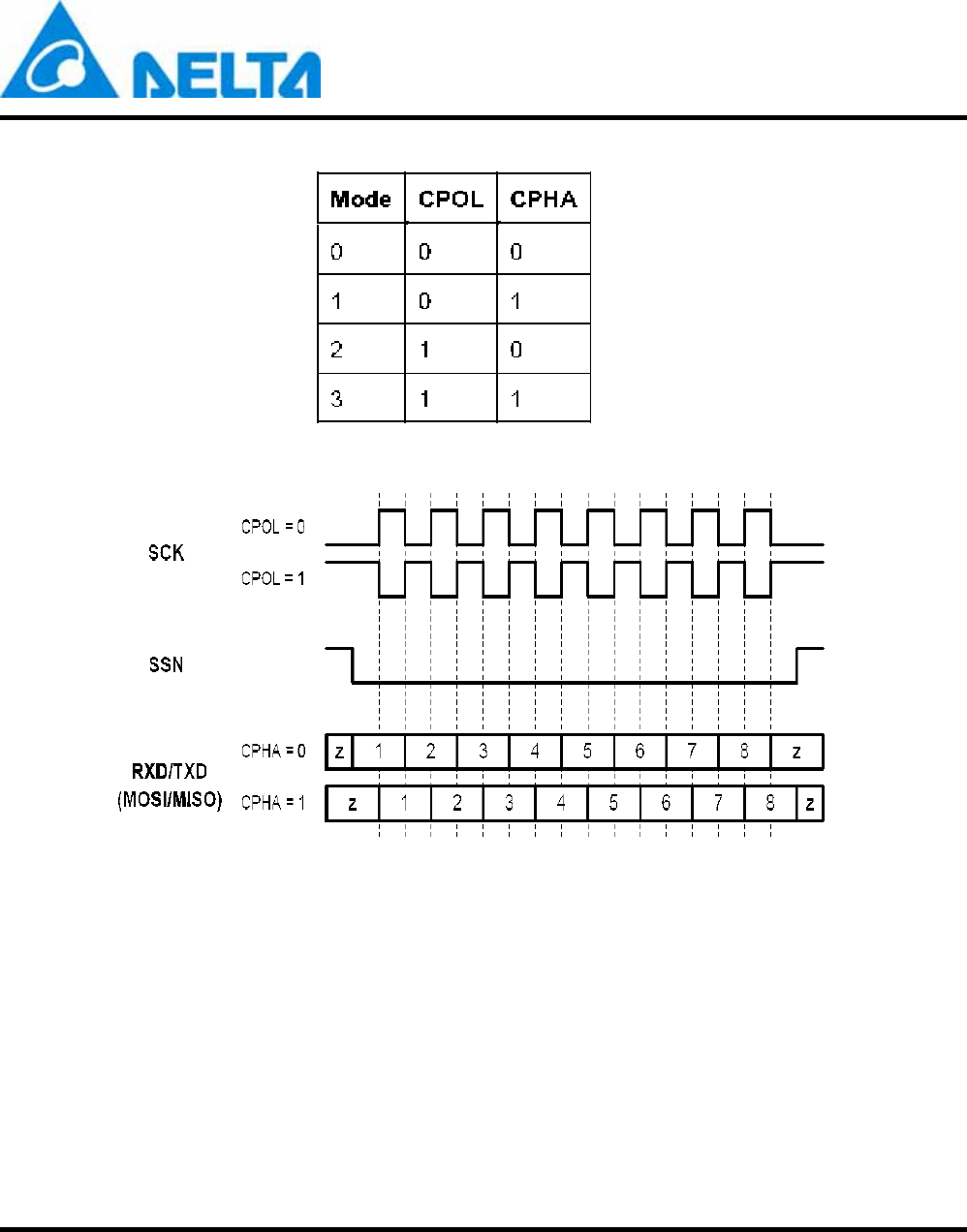
DFCM-NNN50-DT0R
Preliminary Data Sheet Sheet 34 of 41 Jun 27 2017
Proprietary Information and Specifications are Subject to Change
Table 10-29 SPI Slave Interface Pin Mapping
Figure 10-4 SPI Slave Clock Polarity and Clock Phase Timing
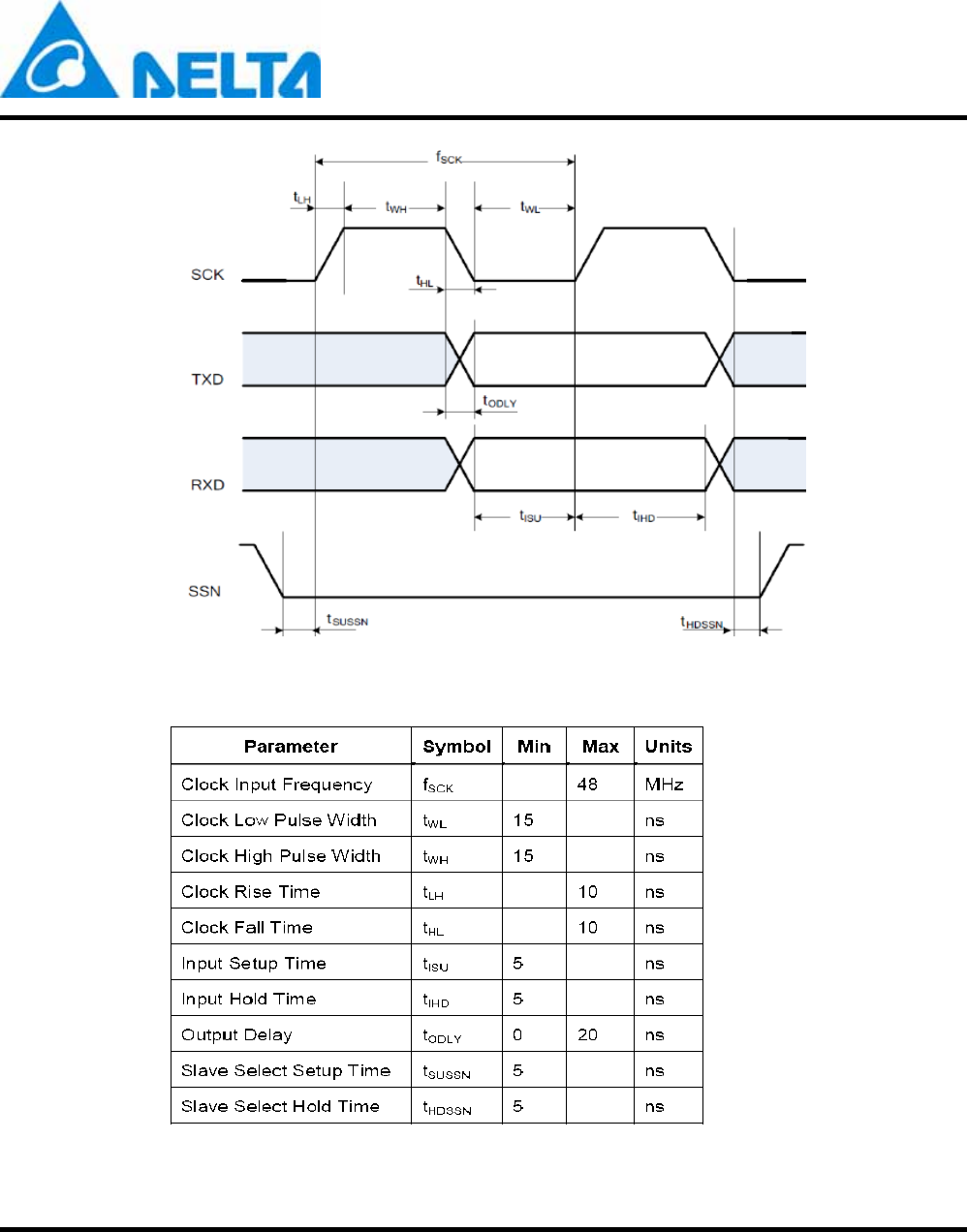
DFCM-NNN50-DT0R
Preliminary Data Sheet Sheet 35 of 41 Jun 27 2017
Proprietary Information and Specifications are Subject to Change
Figure 10-5 SPI Slave Timing Diagram
Table 10-30 SPI Slave Timing Parameters
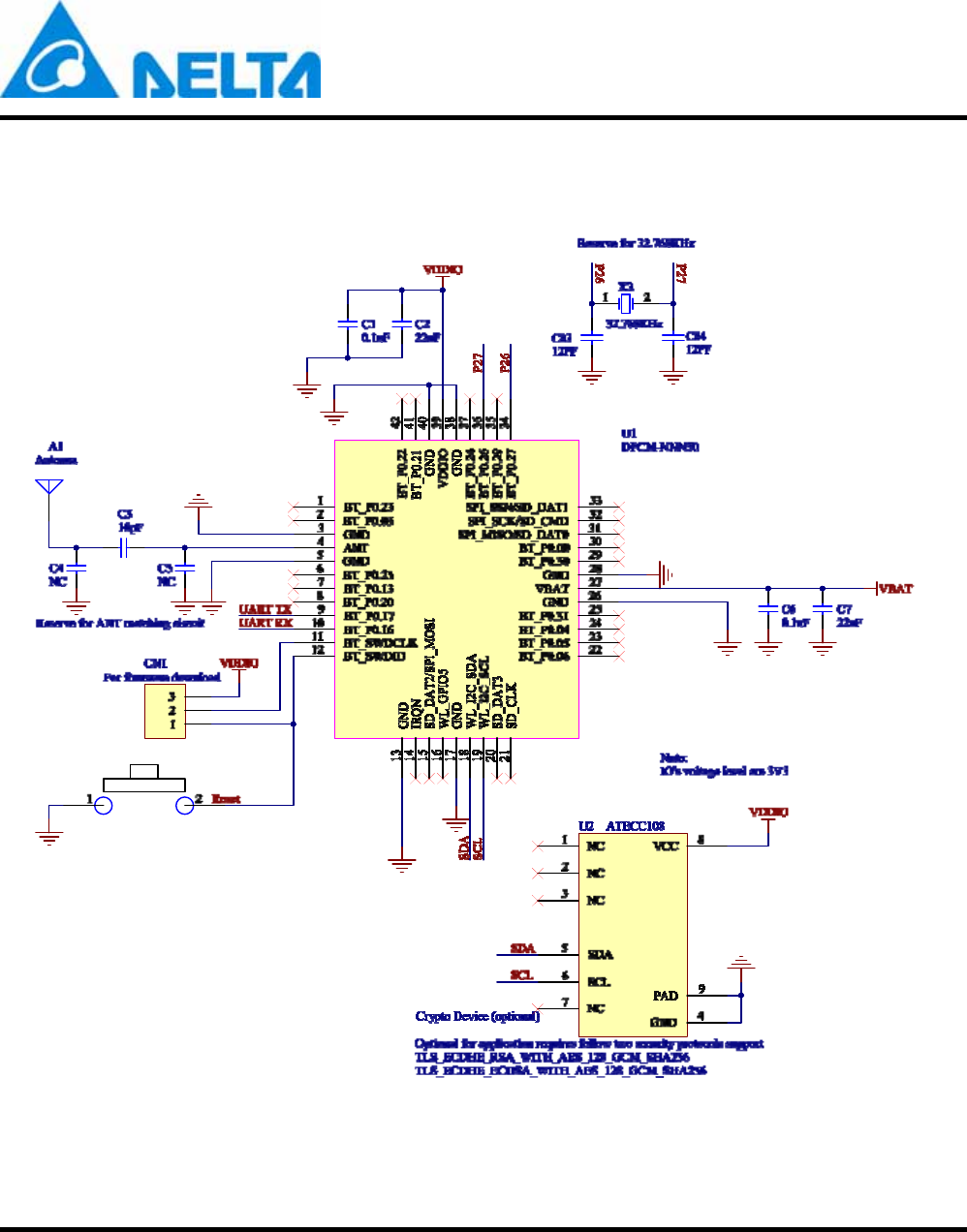
DFCM-NNN50-DT0R
Preliminary Data Sheet Sheet 36 of 41 Jun 27 2017
Proprietary Information and Specifications are Subject to Change
11. Reference Circuit
11-1. Standard Mode
Figure 11-1 DFCM-NNN50-DT0R Reference Circuit for UART interface
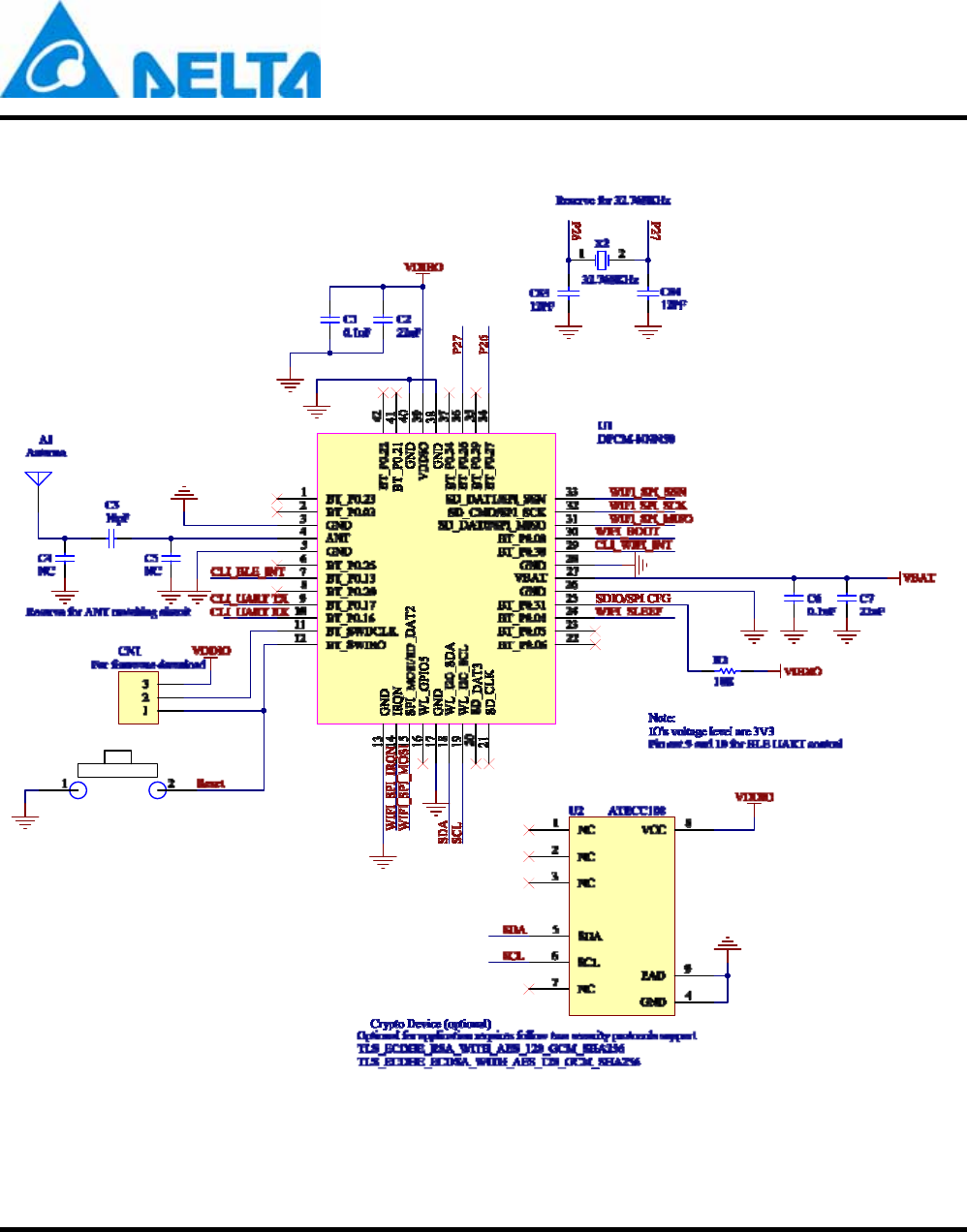
DFCM-NNN50-DT0R
Preliminary Data Sheet Sheet 37 of 41 Jun 27 2017
Proprietary Information and Specifications are Subject to Change
11-2. High Speed Mode
Figure 11-2 DFCM-NNN50-DT0R Reference Circuit for SPI interface
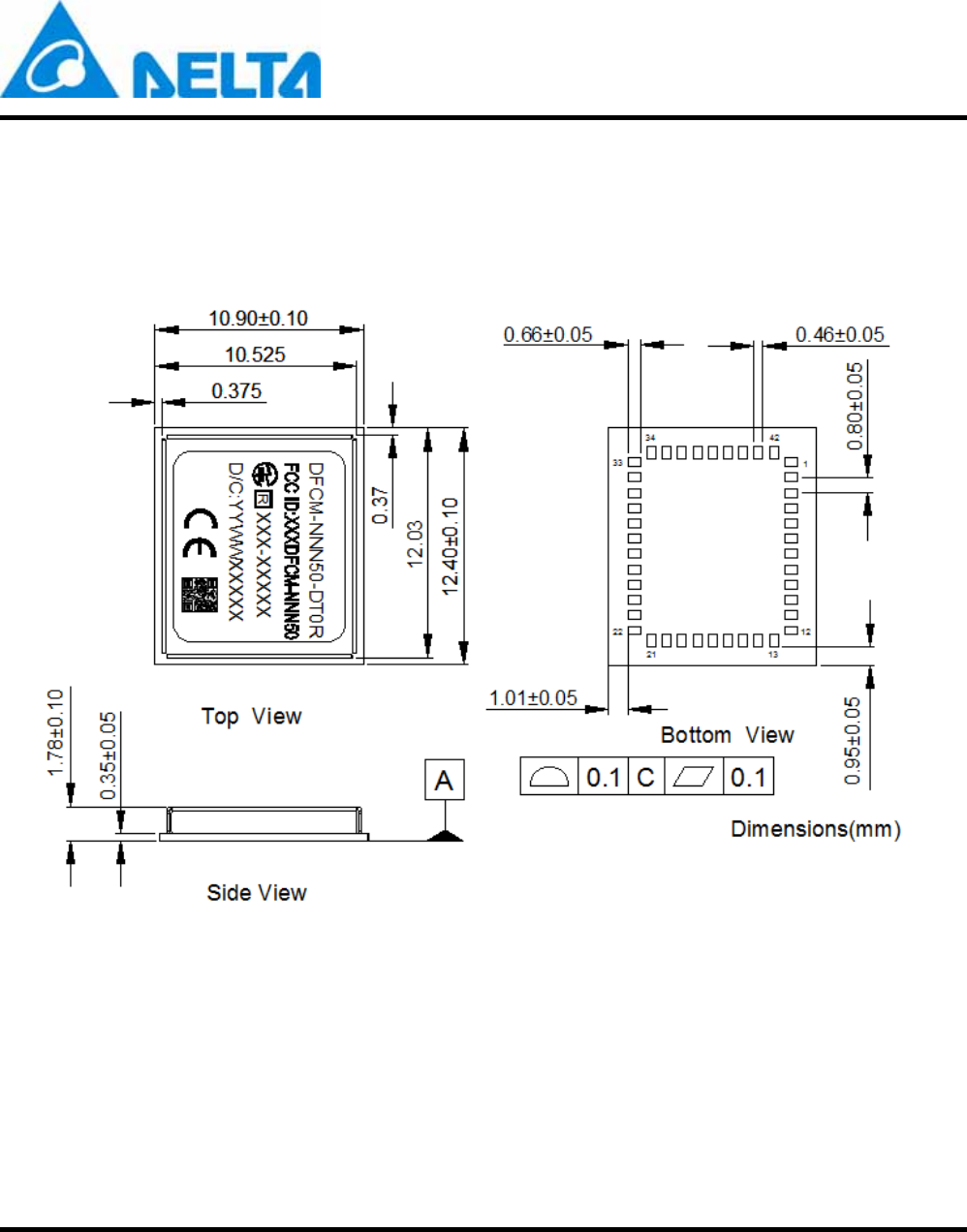
DFCM-NNN50-DT0R
Preliminary Data Sheet Sheet 38 of 41 Jun 27 2017
Proprietary Information and Specifications are Subject to Change
12. Module Dimensions (mm)
Figure 12-1 DFCM-NNN50-DT0R Module Dimension
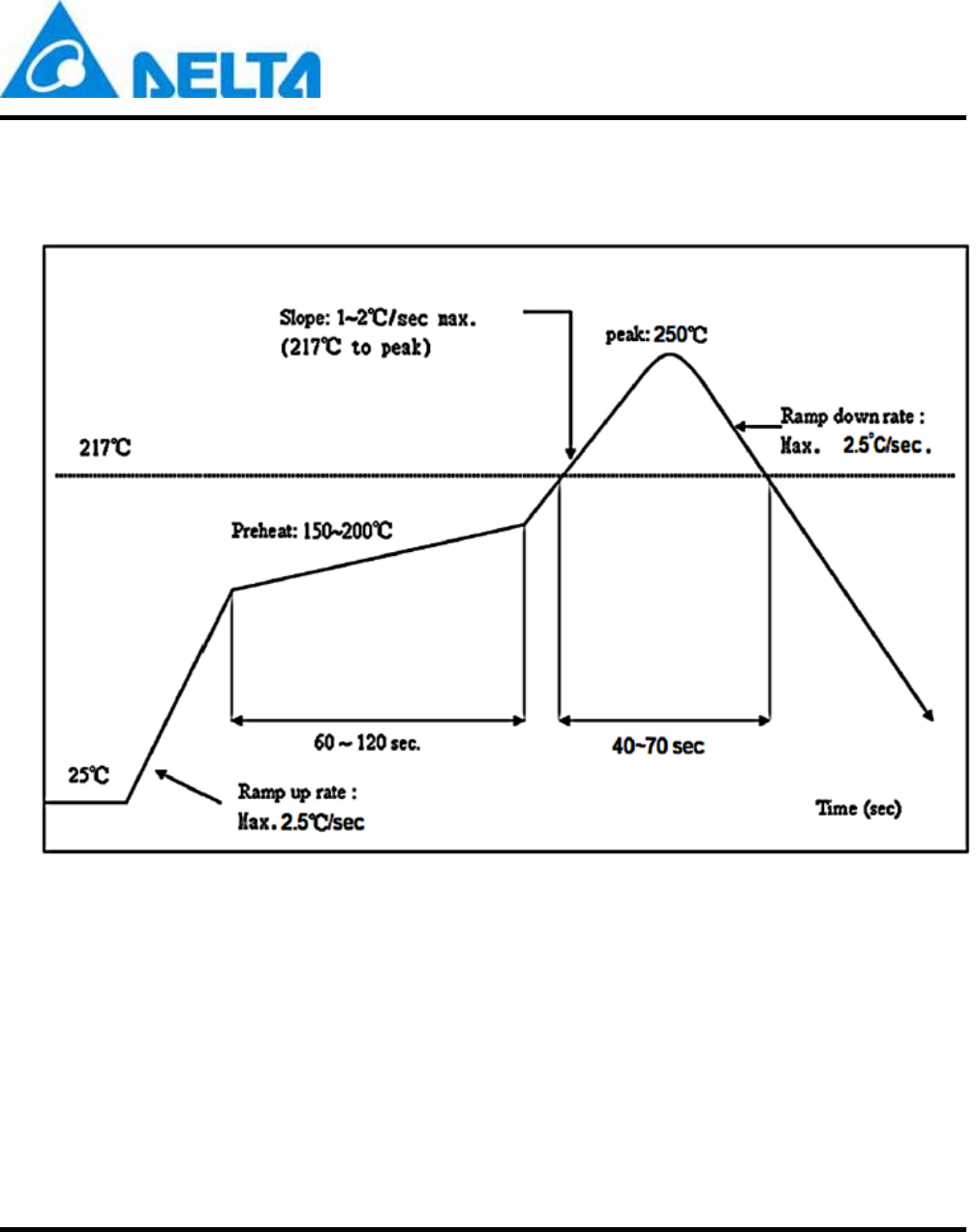
DFCM-NNN50-DT0R
Preliminary Data Sheet Sheet 39 of 41 Jun 27 2017
Proprietary Information and Specifications are Subject to Change
13. Recommend Soldering Conditions
Figure 13-1 Reflow temperature Profile

DFCM-NNN50-DT0R
Preliminary Data Sheet Sheet 40 of 41 Jun 27 2017
Proprietary Information and Specifications are Subject to Change
14. Important Notice
14.1 Federal Communications Commission (FCC) Notice
You are cautioned that changes or modifications not expressly approved by the part responsible for
compliance could void the user’s authority to operate the equipment.
This equipment has been tested and found to comply with the limits for a Class B digital device, pursuant
to part 15 of the FCC rules. These limits are designed to provide reasonable protection against harmful
interference in a residential installation.
This equipment generates uses and can radiate radio frequency energy and, if not installed and used in
accordance with the instructions, may cause harmful interference to radio communications. However,
there is no guarantee that interference will not occur in a particular installation. If this equipment does
cause harmful interference to radio or television reception, which can be determined by turning the
equipment off and on, the user is encouraged to try to correct the interference by one or more of the
following measures:
-Reorient or relocate the receiving antenna.
-Increase the separation between the equipment and receiver.
-Connect the equipment into an outlet on a circuit different from that to which the receiver is connected.
-Consult the dealer or an experienced radio/TV technician for help.
This device complies with part 15 of the FCC Rules. Operation is subject to the following two conditions:
1) this device may not cause interference and
2) this device must accept any interference, including interference that may cause undesired operation
of the device.
RF Radiation Exposure Statement:
1. This Transmitter must not be co-located or operating in conjunction with any other antenna or
transmitter.
2. This equipment complies with FCC RF radiation exposure limits set forth for an uncontrolled
environment. This equipment should be installed and operated with a minimum distance of 20
centimeters between the radiator and your body.

DFCM-NNN50-DT0R
Preliminary Data Sheet Sheet 41 of 41 Jun 27 2017
Proprietary Information and Specifications are Subject to Change
Required end product labeling:
Any device incorporating this module must include an external, visible, permanent marking or label
which states: “Contains FCC ID: H79DFCM-NNN50.”
Manual Information to the End User
The OEM integrator has to be aware not to provide information to the end user regarding how to install
or remove this RF module in the user’s manual of the end product which integrates this module. The end
user manual shall include all required regulatory information/warming as shown in this manual.
14.2 National Communications Commission (NCC) Notice
根據 NCC 低功率電波輻射性電機管理辦法規定:
第十二條 經型式認證合格之低功率射頻電機,非經許可,公司、商號或使用者均不得擅自變更頻率、加
大功率或變更原設計之特性及功能。
第十四條 低功率射頻電機之使用不得影響飛航安全及干擾合法通信;經發現有干擾現象時,應立即停
用,並改善至無干擾時方得繼續使用。前項合法通信,指依電信法規定作業之無線電通信。低功率射頻電
機須忍受合法通信或工業、科學及醫療用電波輻射性電機設備之干擾。
此模組於取得認證後將依規定於模組本體標示審驗合格標籤,並要求平台廠商於平台上標示 「本產品內
含射頻模組:ID 編號」字樣。